All About Kulpakji Jain Tirth near Hyderabad
We arrived at the village of Kolunapaka expecting to see Kulpakji, a small, ancient Jain tirth in semi-ruins. Instead, we found the new, well-kept temple surrounded by gardens, museum, dining facilities excellent Jain dharamshala near Hyderabad, and more. We spent the next few hours sorting the contradictions, tying the stories of past and present. At the end of the day, I was glad I had Kulpakji as one places to visit near Hyderabad.
Contents
- First Impressions of Kulpakji Jain Swetambar Mandir
- Stories of Kolunapaka’s History
- Important Jain Statues in Kolunapaka
- Kulpakji Museum, a Rich Collection of Jain Artifacts
- Food at Kulpakji Bhojanshala in Kolunapaka
- Accommodation/Dharamshala in Kulpakji Temple, a Jain Tirth
- What to Wear at Kulpakji Temple
- Kulpakji Hours and Important Dates
- Tips to Visit Kulpakji Jain Tirth of South India
- People at Kulpakji Temple
- Restoration of Kulpakji Temple
- Related Articles
- Check out additional Religious Monuments
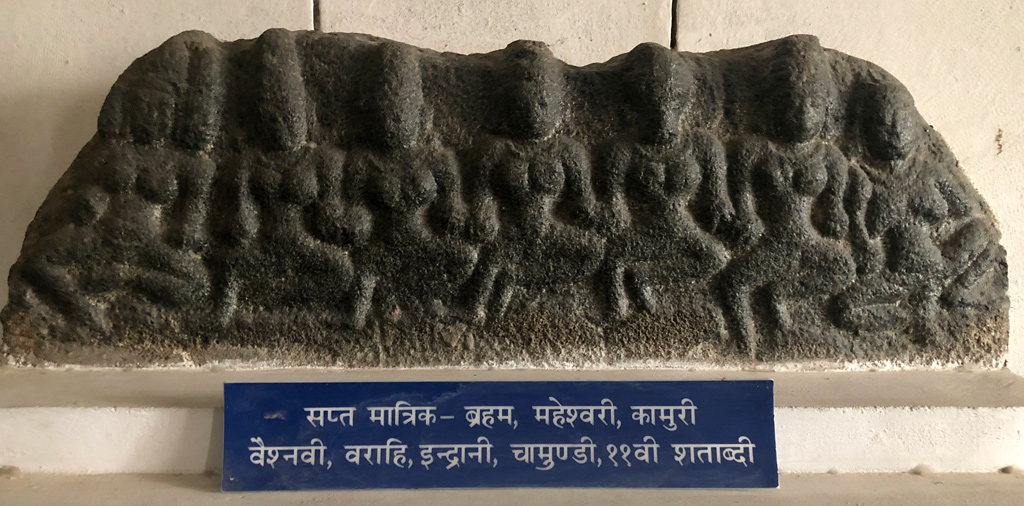
I visited Kulpakji because as a Jain and a history buff, I was curious about Jain history in Telangana and I had a few hours before my flight. As the presence of global technology giants in Hyderabad is booming, so is the growth of business travelers. However, there are few options for local hosts to take their business partners other than shopping, Ramoji film city, Charminar, Birla temple, Hussain Sagar Lake, Salar Jung Museum and Golkonda fort. The long history of Kulpakji should attract business travelers that are curious about Indian history.
First Impressions of Kulpakji Jain Swetambar Mandir
As we entered the grand gate of the Kulpakji complex, friendly guards greeted us and showed us where to park.
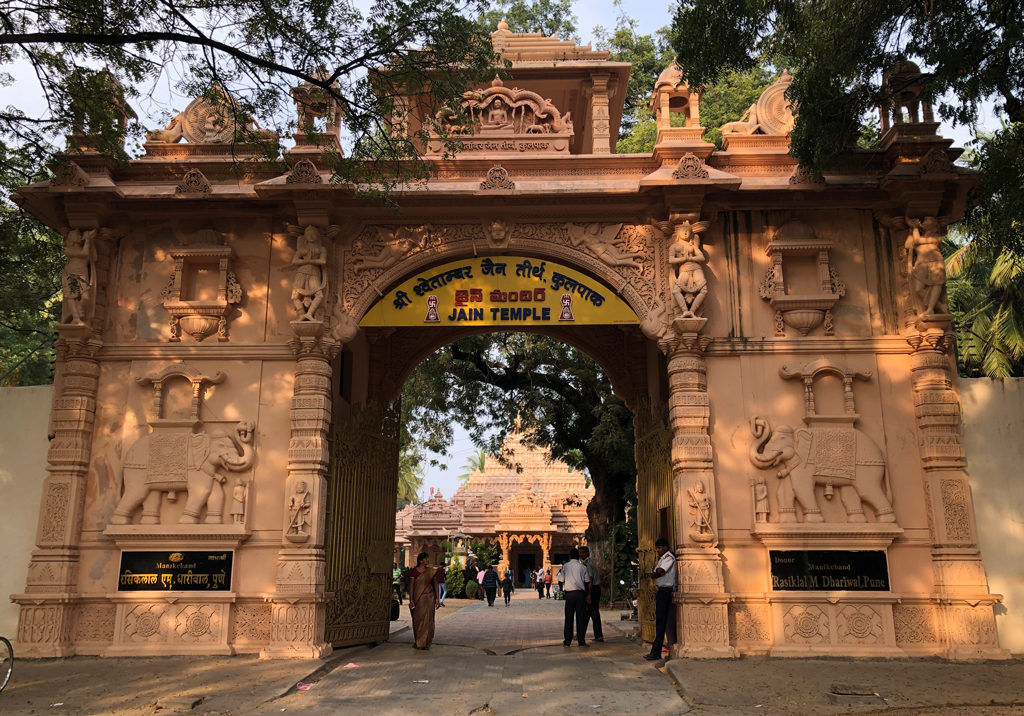
The path straight ahead leads into the all important Kulpakji temple of Kolunapaka.
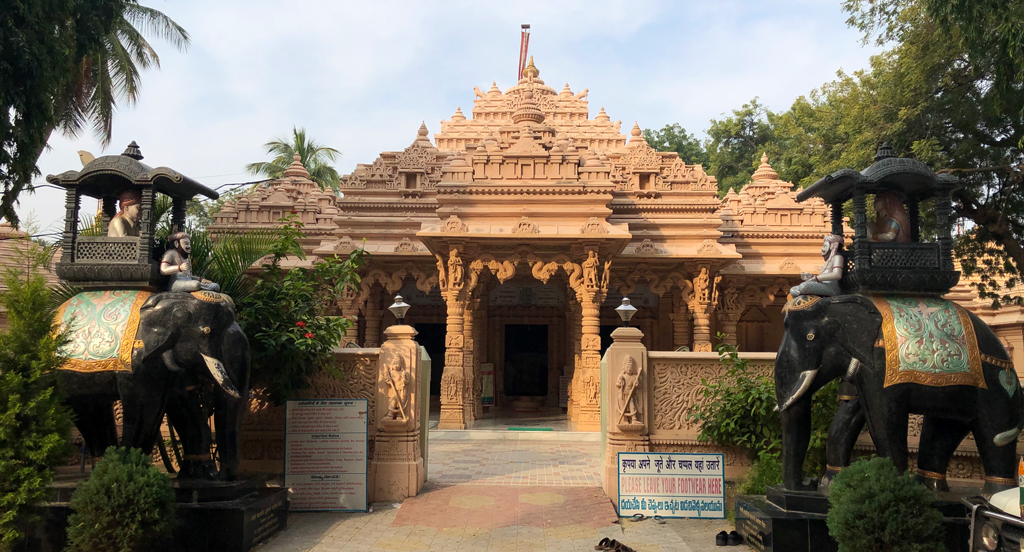
Inside the main temple is a passage along the perimeter lined with statues, a central hall and narrow passages leading up to the three main statues of Adinath Bhagwan, MahavirSwamii, and NeminathBhagwann.
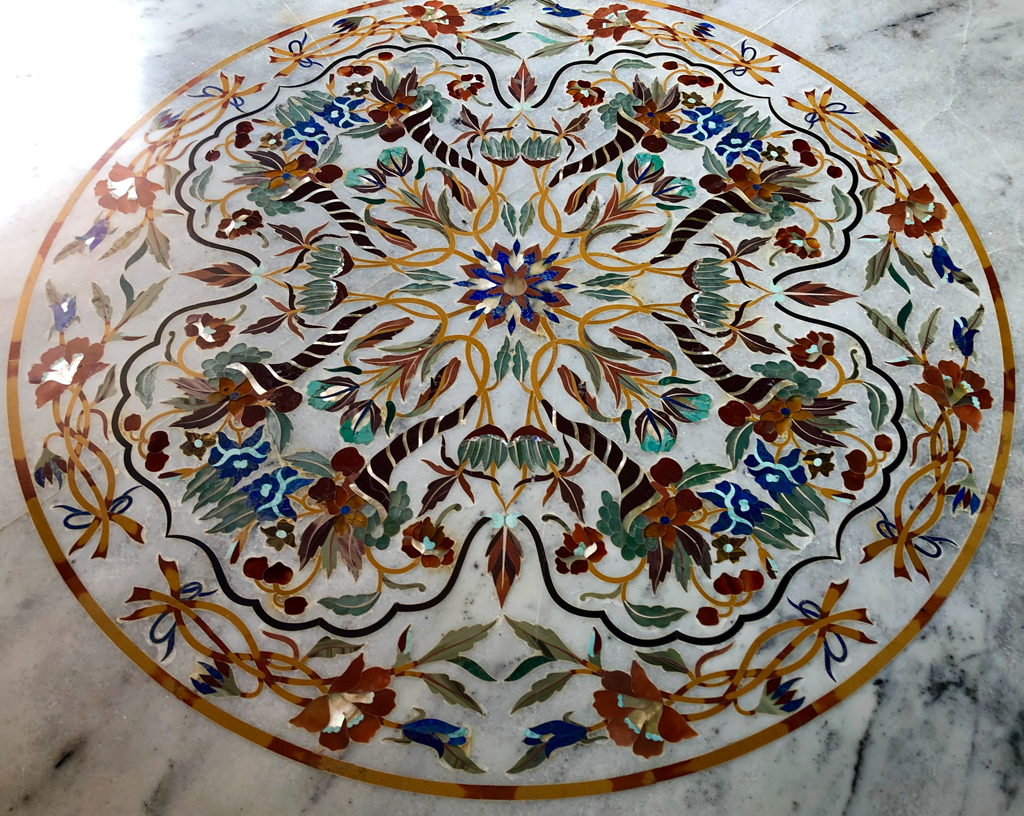

The first room next to the entrance is the office that dispenses lunch coupons, does accommodation assignment and answers visitor questions.
Stories of Kolunapaka’s History
Like any ancient site, Kulpakji has many legends and mythological folk tales that have been passed down over hundreds or thousands of years. Quite likely the tales have evolved with each generation. Different sources tell different timelines of the temple. Some sources indicate a start in the 7th century, others say the temple is 2,000 years old and yet others say its much older. I couldn’t to tell the exact timeframe.
According to the information pamphlet at Kulpakji temple – Prabhu Surya ji, an ancient scholar, wrote a detailed narration of the birth of Manikya Dev’s statue. (Manikya Dev is the local name for Adinath Bhagwan, the first Tirthankar) statue – Once upon a time on Ashtapath mountain, Bharath Chakravarti established magnificent jewel-studded statues of the 24 Tirthankars. The statue of Adinath Bhagwan was sculpted with all important symbols on arms, hair, navel etc to provide maximum benefit to its worshipper. Manikya Dev’s statue was worshipped by some of the greatest people that lived in Bharat (India) over the centuries.
One time Narad Muni (the messenger/gossip spreader) was visiting earth on Vaitadia Parvati and heard all about the magnificence of Manikya Dev’s statue. He inquired about its origins and learned that it was brought from Ayodhya and was of utmost importance. Upon learning all about the statue Narad muni went to Indra Bhawan’s court in heaven and narrated the magnificence of the statue. So, Indra Bhagwan acquired the statue for the Gods to worship.
Later Queen Mandodari heard of the statue and had the urge to worship. When King Ravana, the great Brahmin scholar learned of his queen’s desire, he procured Manikya Dev’s statue from Indra Dev for her. She became a devout worshipper and took great care of it. (Read Ravana’s story)
Many years later, Manikya Dev visited Queen Mandodari in her dreams and told her of the upcoming devastation of Lanka and death of Ravana. When Queen Mandodari urged Ravan to not kidnap Sita Devi and warned him of the horrors it would cause and Ravan dismissed her warnings, Mandodari knew something had to be done. To save Manikya Dev’s statue, she had it submerged in the ocean where it was worshipped by the Ocean gods.
A few centuries later, Jain King Shankar of Kalyan city of Kannand kingdom of Southern India was very distressed because of Mithya Devi’s spread of havoc through his kingdom. At that time, Padmavati Devi had a vision of Manikya Dev’s statue. She heard in the dream that if the king brought Manikya Dev’s statue from the Ocean, it would cure all the problems of his kingdom. So, the king started worshipping with powerful yagnas and mantras. The Ocean God appeared and offered all kinds of valuable jewels. But King Shankar only wanted the statue of Manikya Dev that had been worshipped by Queen Mandodari. The Ocean King gave the statue to the King with some conditions
- He will not have any doubts about the statue.
- He will carry the statue behind him.
- He will not look back as he carries the statue.
When he arrived at a location, he could not feel the weight of the statue, so instinctively he turned around. When he turned around, the statue had decided to stay put. So, the king built the temple around location chosen by the statue. As the workers dug the ground they found many statues buried at the location and surrounding areas. The statues were then established in the temple. The temple still stands on the same location in Kolunapaka village.
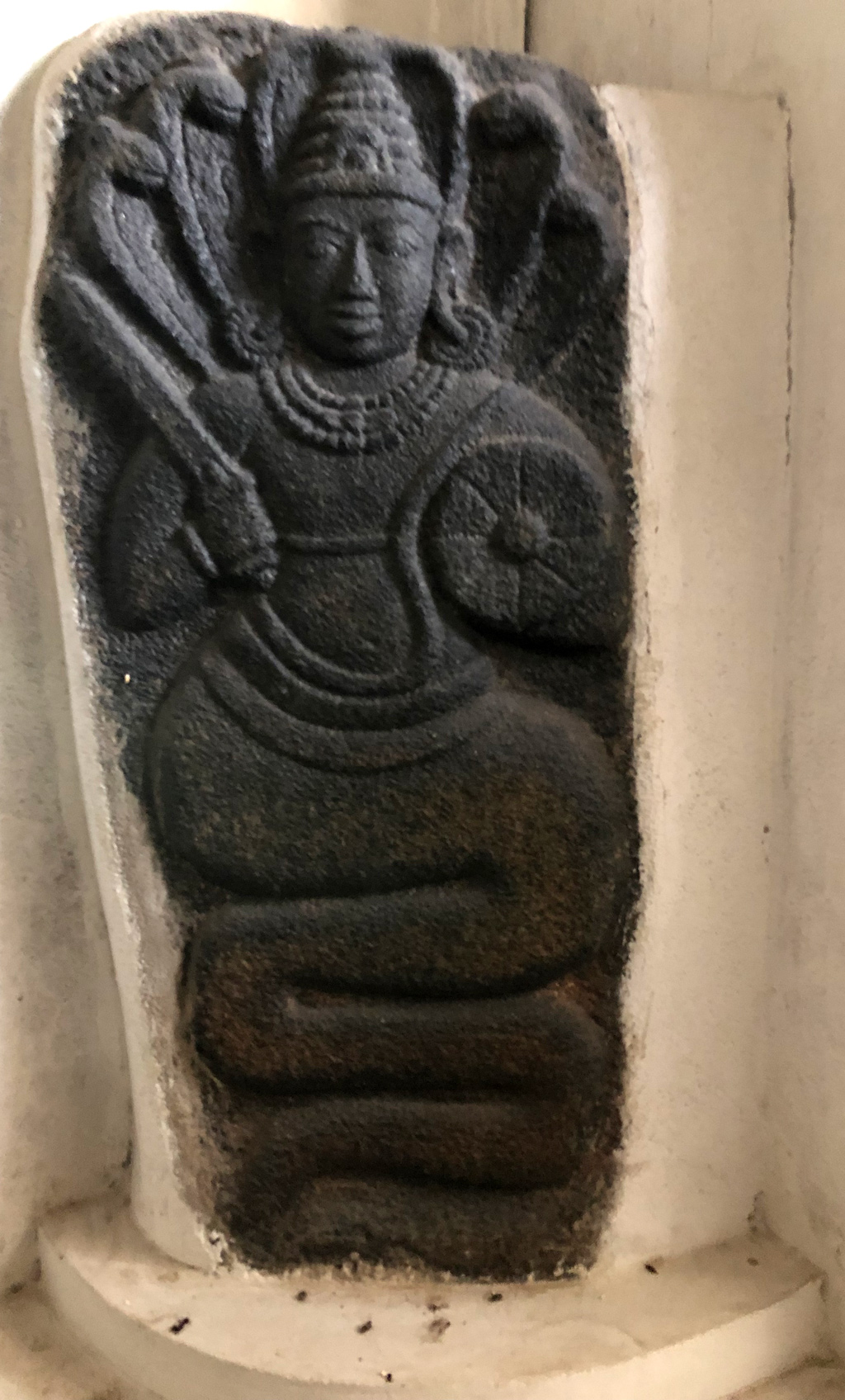
It is common knowledge that Karnataka had many Jain kingdoms. But, most people don’t know that the town of Kolunapaka and the surrounding region was considered the most important Jain site of Southern India. It had a large Jain population for centuries. However, the population dwindled and the temple fell to disarray for centuries thereafter. It was always considered as the most important Jain tirth of the South so people made the long and difficult journey all the way to the remote village Kolunapaka and the Jain tirth of Kulpakji.
Important Jain Statues in Kolunapaka
Adinath Bhagwan’s Statue
The main statue in this temple is that of Adinath Bhagwan, locally known as Manikya Dev.
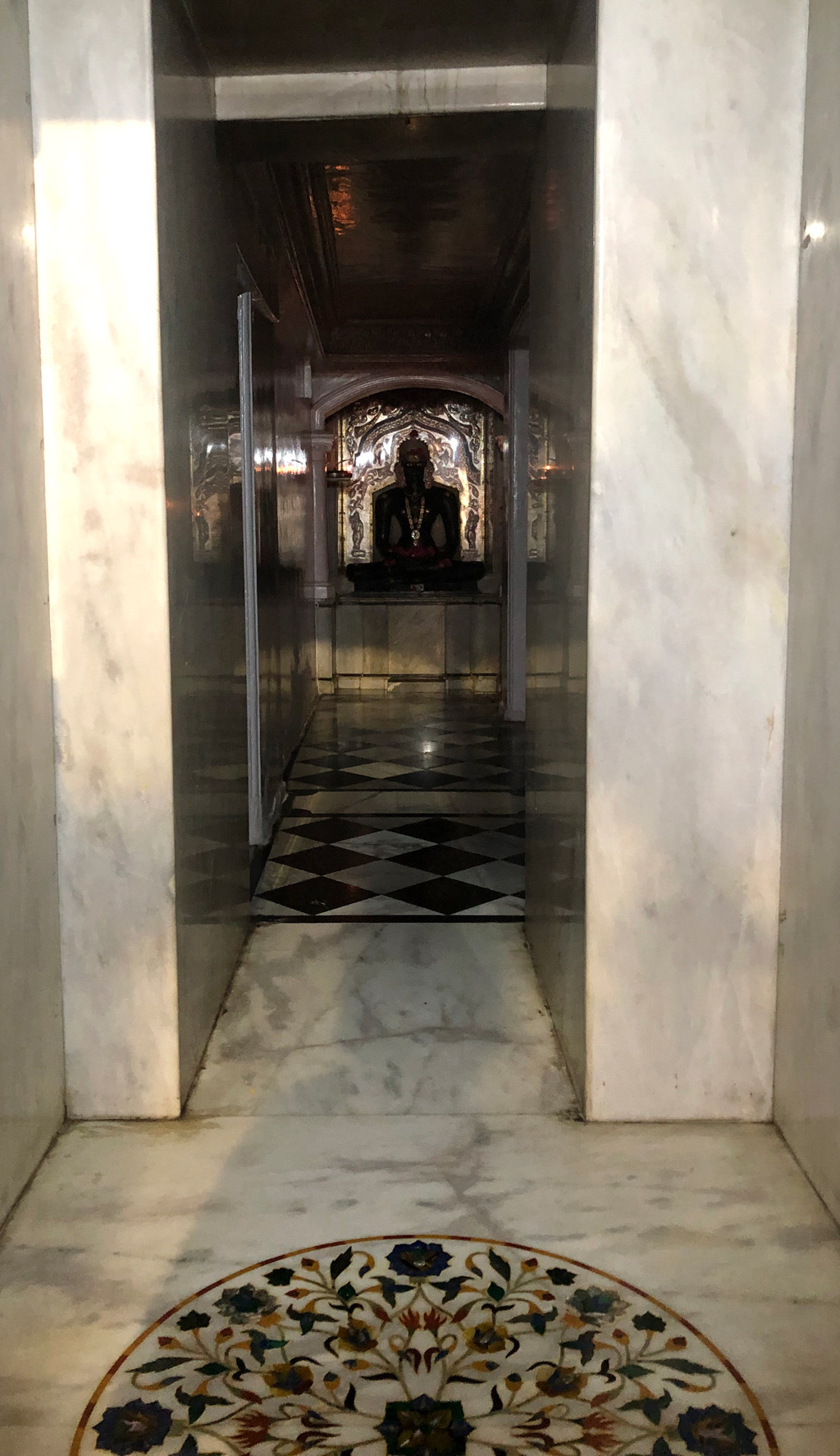
The statue is said to have been commissioned by Bharat Chakravarti, son of Adinath Bhagwan. India was given its name ‘Bharat’ for his virtues and victories. Some say the statue is from the seventh century and others believe its much older.
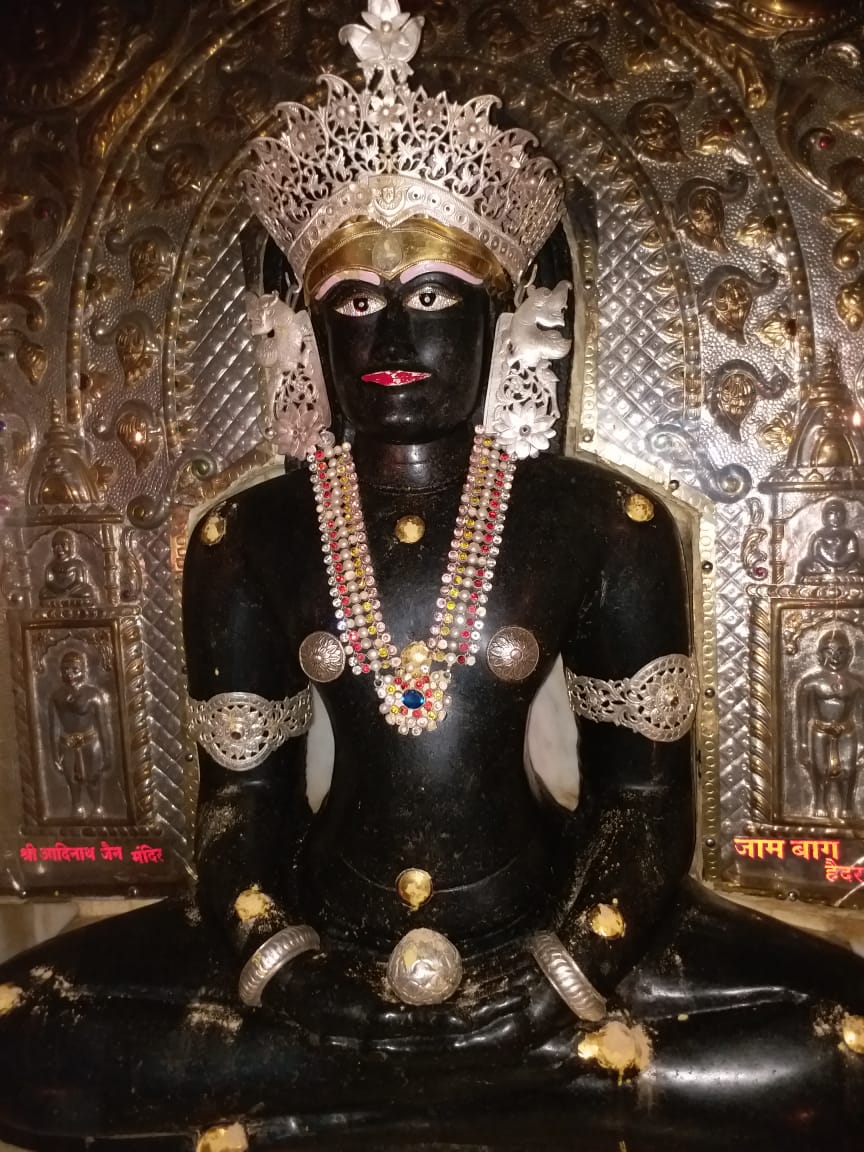
The statue looks black (people say it’s actually green). It’s made in a distinctive Southern Indian style and adorned with many jewels. Several of it’s features have eroded because it has been worshipped for such a long time.
Mahavir Swami’s Unique Turquoise Statue
The turquoise statue of Mahavir swami is one of a kind ever found in India. They say its made from Jade. The artistic style, the big eye, and huge smile is unlike any statue of Mahavir Bhagwan in the world.
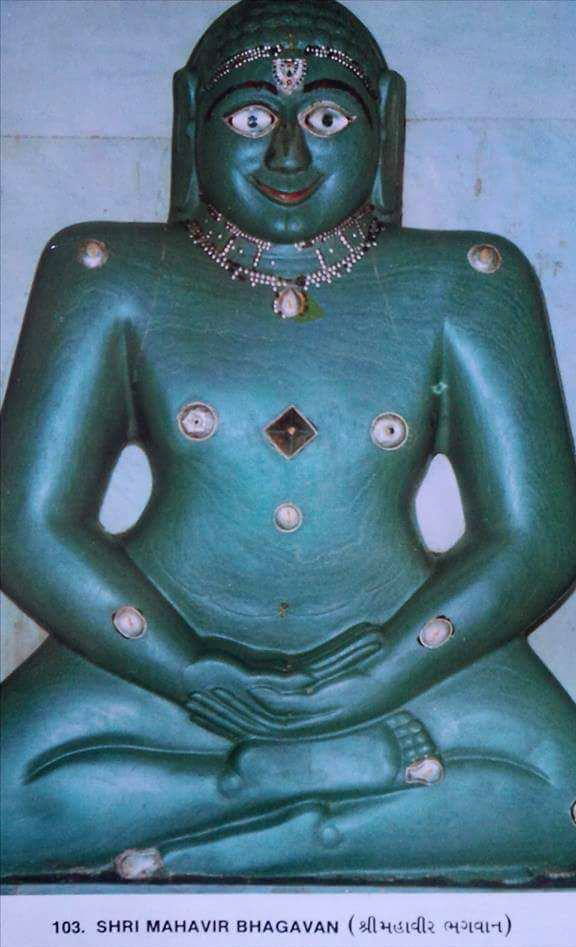
The statue is housed to the right of Adinath Bhagwan’s statue. It’s not clear how old this unusual statue really is.
Neminath Bhagwan’s Statue
Neminath Bhagwan’s statue is located to the left of Adinath Bhagwan’s statue. It’s also made from a black rock, like many of the statues in the temple.
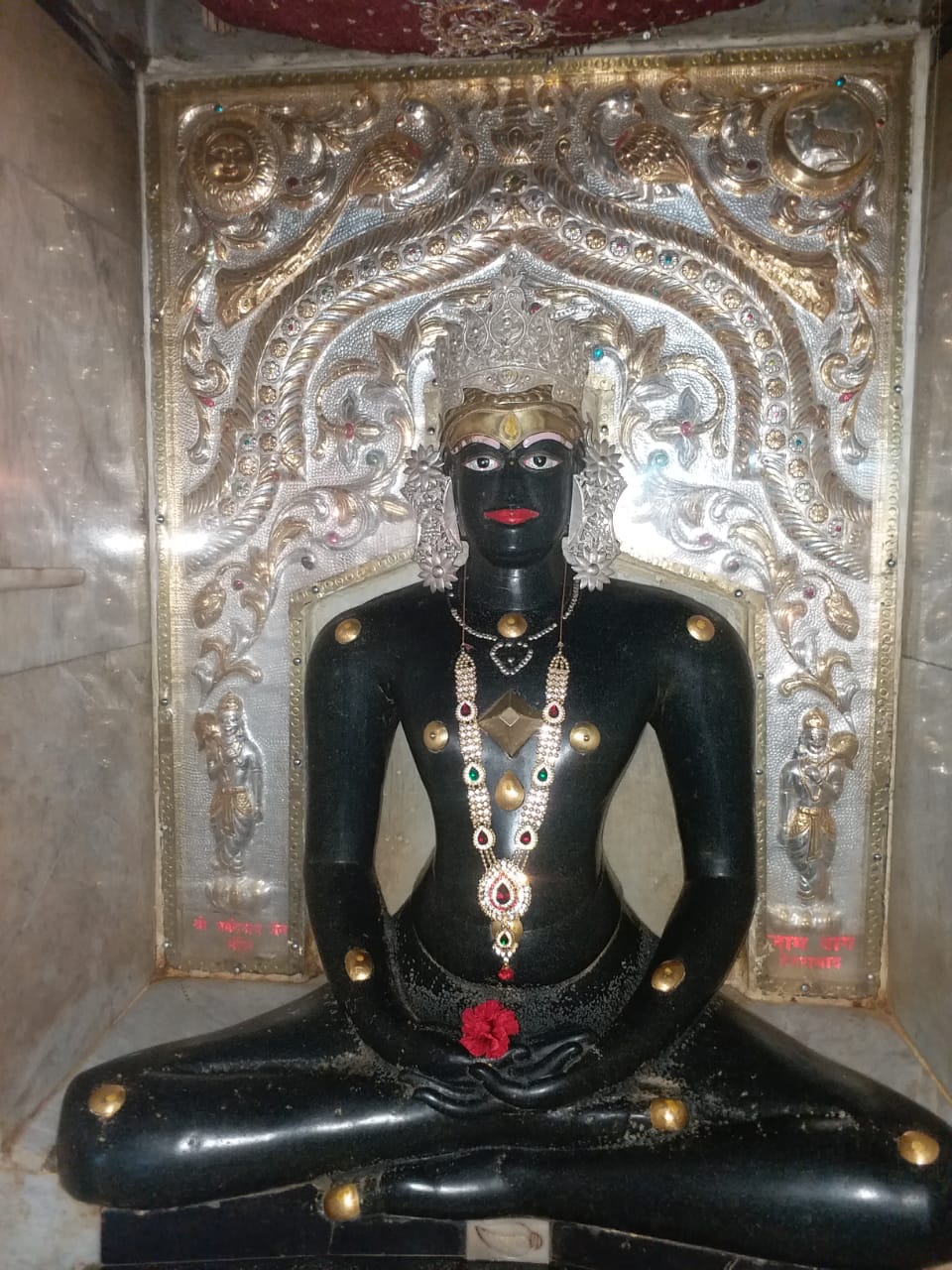
Other Statues in Kulpakji
Kulpakji temple has statues of eight Tirthankaras. I wonder if the other 16 were never established here or if they were lost over the centuries.
Another important and unique statue is that of Padmavati Devi. She is seated at the entrance to Neminath Bhagwan’s hallway. The statue has 12 arms as opposed to the usual 4 arms found in other Padmavati mata’s statues. With this key difference, it would have been hard to say which devi the statue represents. However, the snake symbol on it implies that the statue is that of Padmavati devi. In Southern India, Hindus (and Jains) also worship Padmavati devi, so deviation from the norm is not unusual.

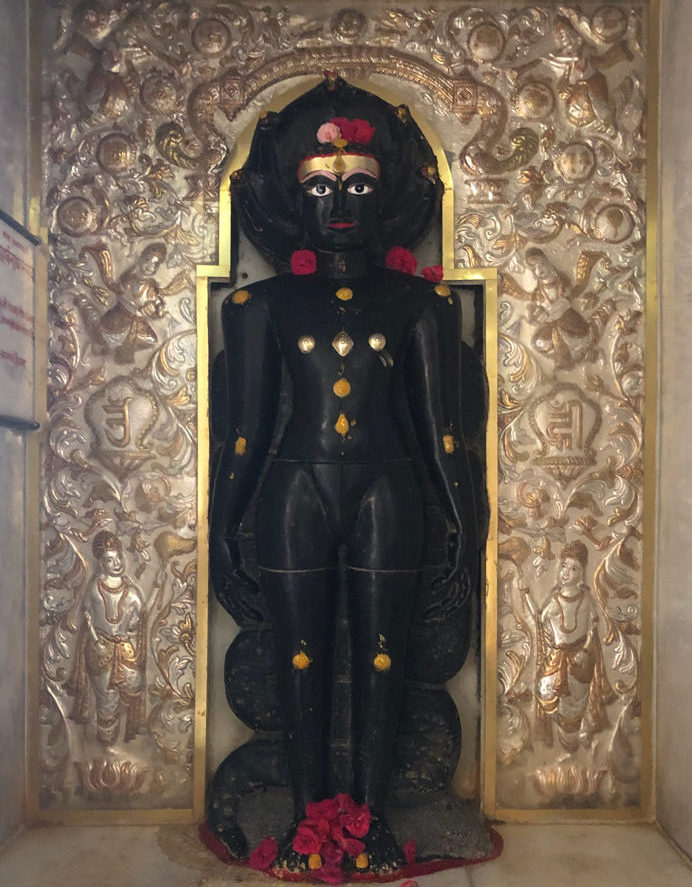
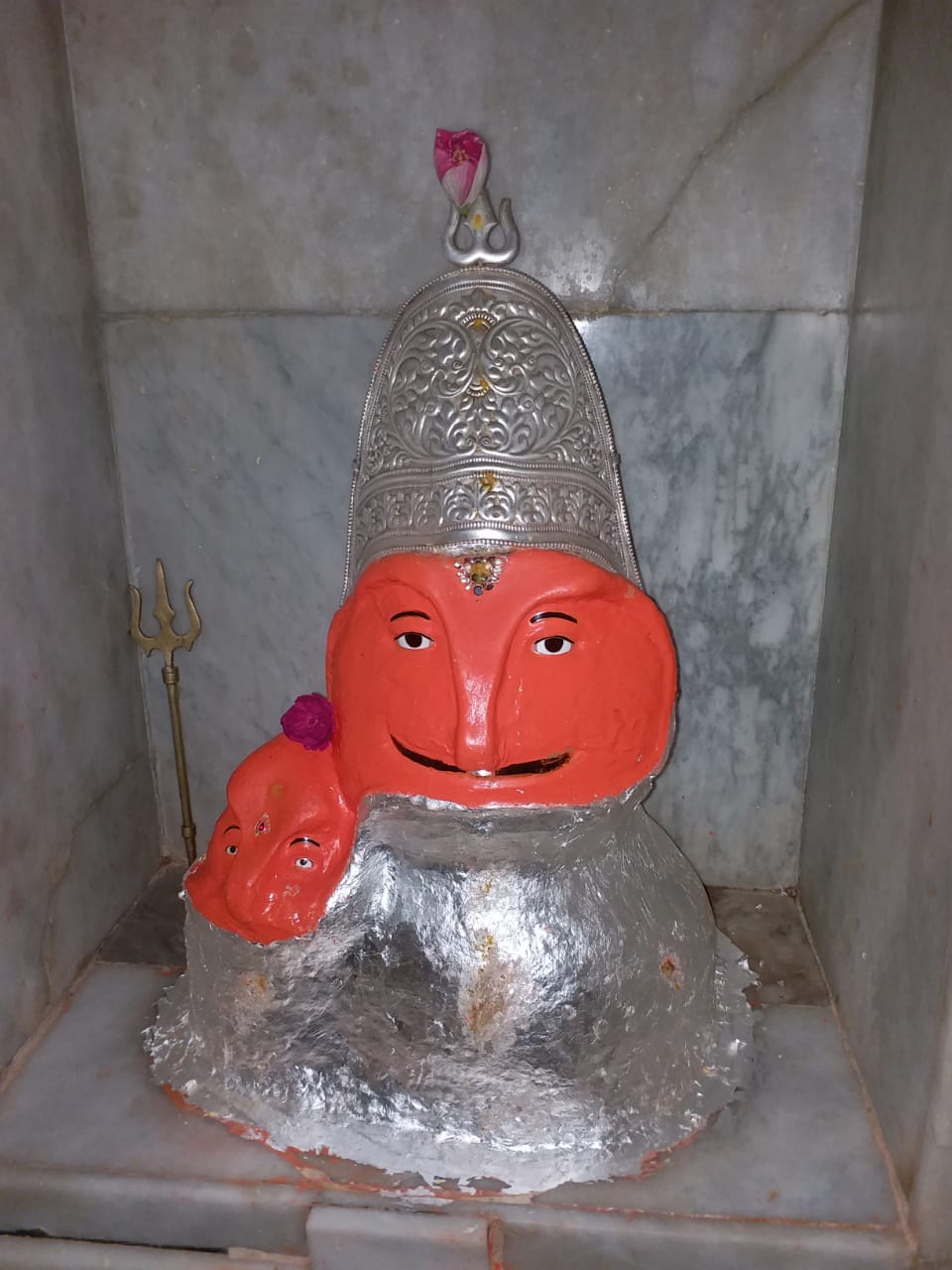
Kulpakji Museum, a Rich Collection of Jain Artifacts
When I first asked the manager to see the museum, he refused, saying that the museum was unkept. It has cobwebs and only a few broken statues. But after some conversations with the caretaker and another devoted follower, they convinced the manager to let us visit the museum, get a brochure and hear their stories. Things turned around and the staff was extremely gracious as to show us the museum and give pictures for this blog.
The museum is a small room next to a storage room filled with pots and pans. They clean up the Kulpakji museum and open it on special occasions. Its generally closed because they rarely have visitors interested in the artifacts. Most visitors are devout Jains that come only to worship. Few people think of it as one of places to visit near Hyderabad. Few people know that it has a good Jain dharamshala in Hyderabad.

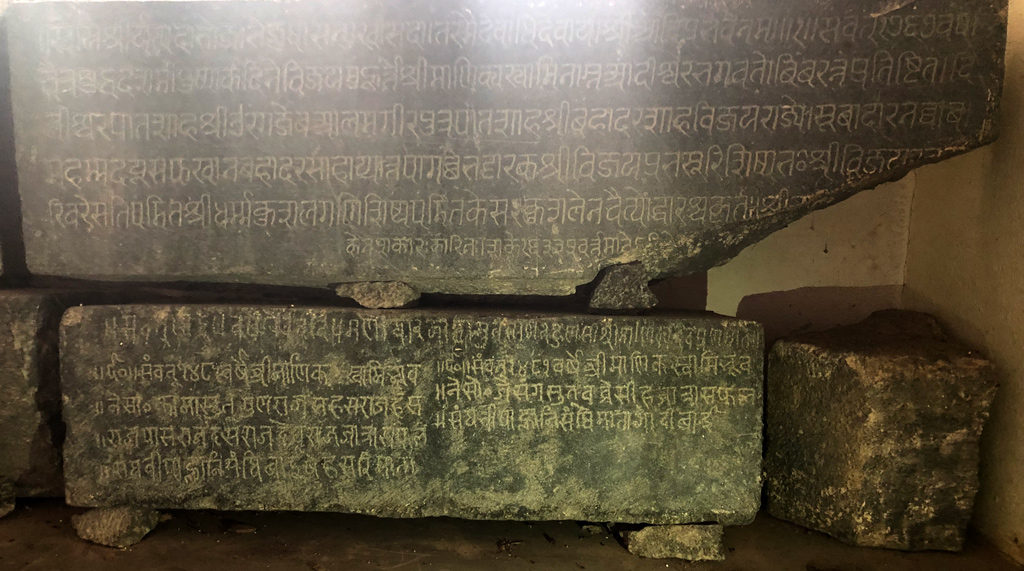
Food at Kulpakji Bhojanshala in Kolunapaka
The Kulpakji temple bhojanalay serves breakfast, lunch, and dinner. The new dining hall and kitchen were built only about 10 years ago at this location. Earlier food was served in what’s now a park next to the temple.
The meals are free but donations are accepted as it’s a pay-it-forward model. Usually, they serve a simple meal for about 100 people but on the day we visited they were expecting 600-700 people because it was the first poornima after chaturmaas and hence an important day for devotees.

We had a really nice breakfast including boondi-bhujia, vada-sambar, upma, pooha, kathi daal, khankra with ghee and masala.
As expected in any Jain temple, the food is vegetarian with no jamikand (food that grows underground). Food is served only after sunrise and before sunset. People visiting the temple as a Jain dharamshala in Hyderabad should know the hours as listed further below.
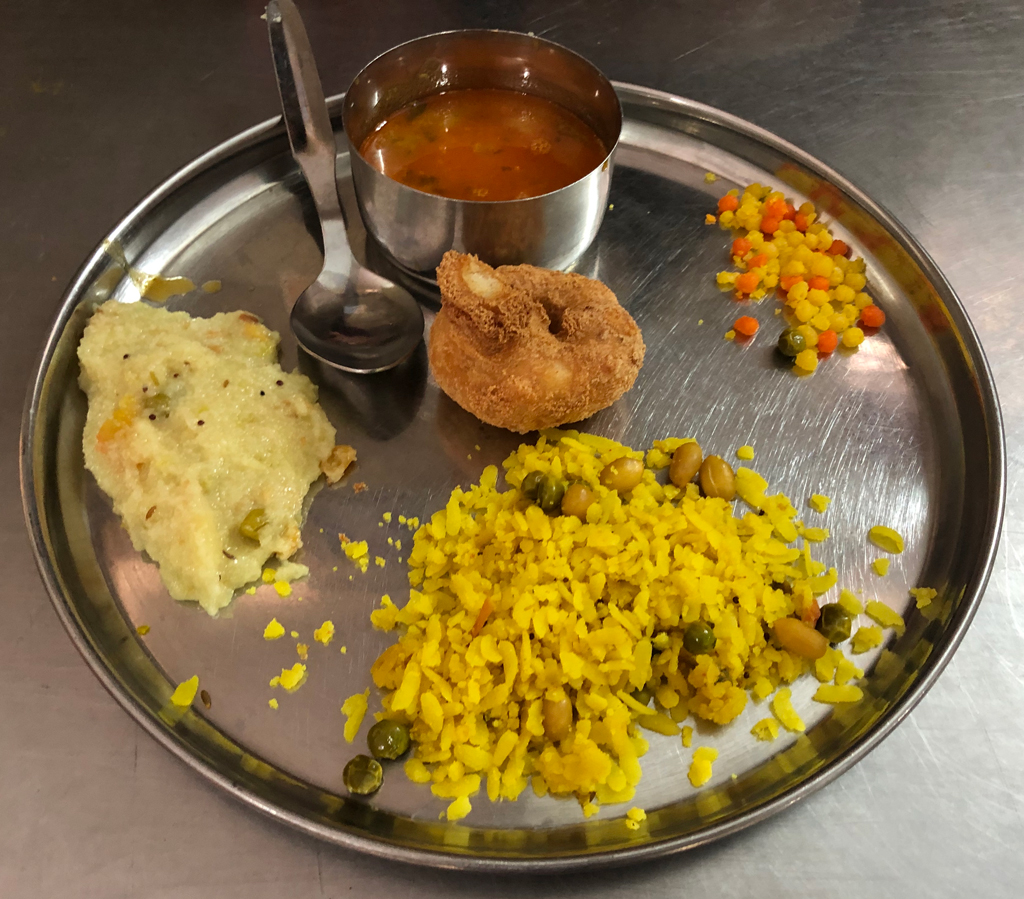
Accommodation/Dharamshala in Kulpakji Temple, a Jain Tirth
Like most Jain temples (and maybe others), Kulpakji has many rooms for visitors. Visitors take rooms to shower and change into Pooja clothes, even if they’re visiting for just a few hours. Like most Jain dharamshalas they have basic amenities that are kept clean by the staff. This is the only Jain dharamshalas in Hyderabad that I’ve visited, although I’ve stayed in other dharamshalas in Rajasthan.
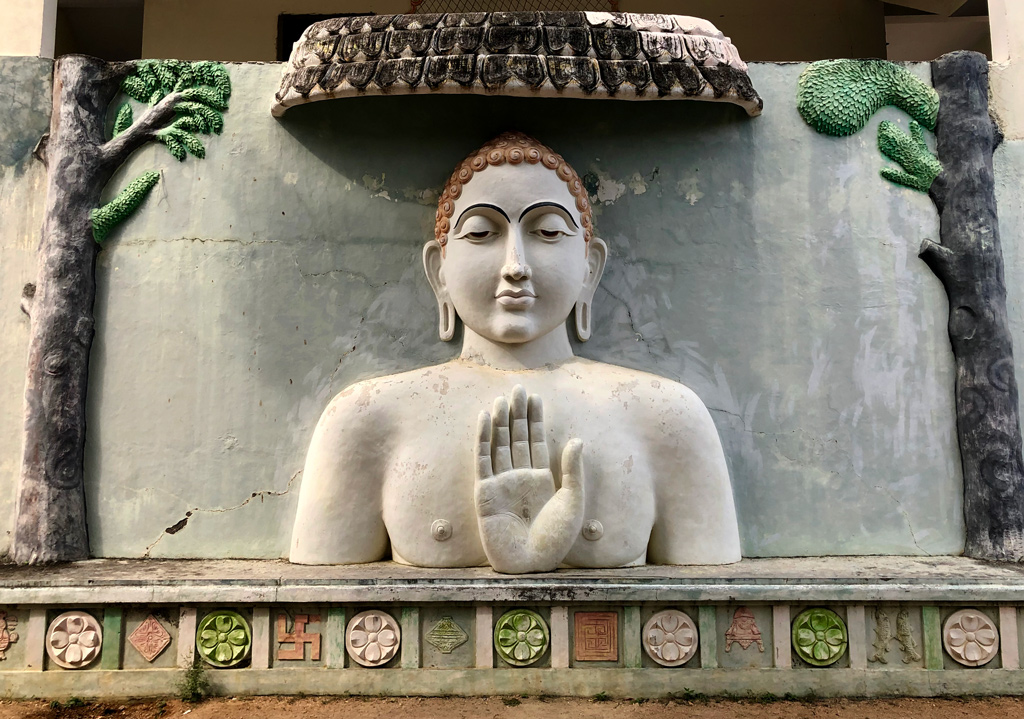
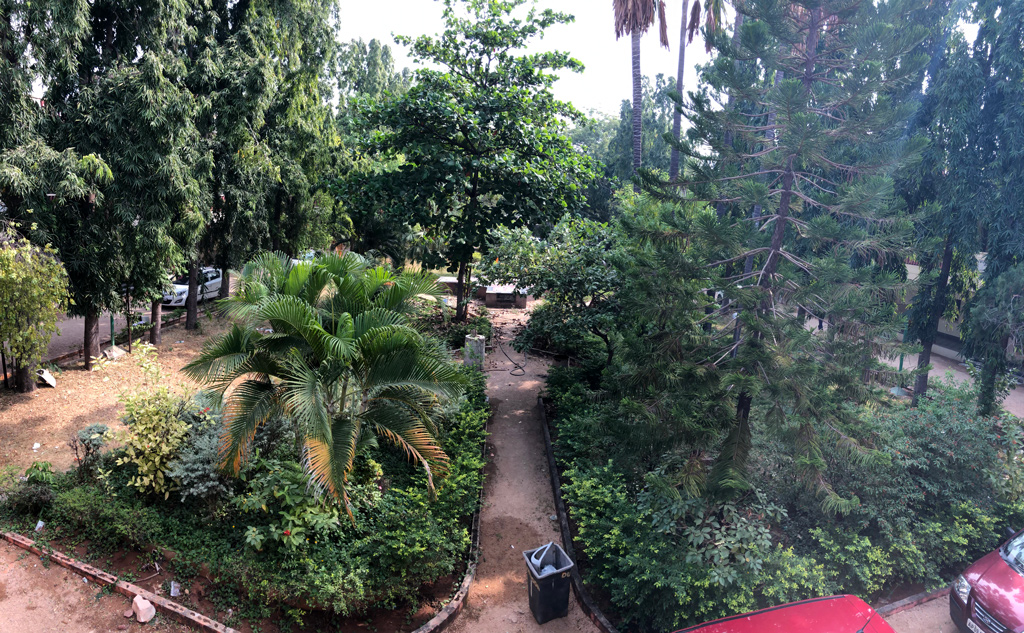
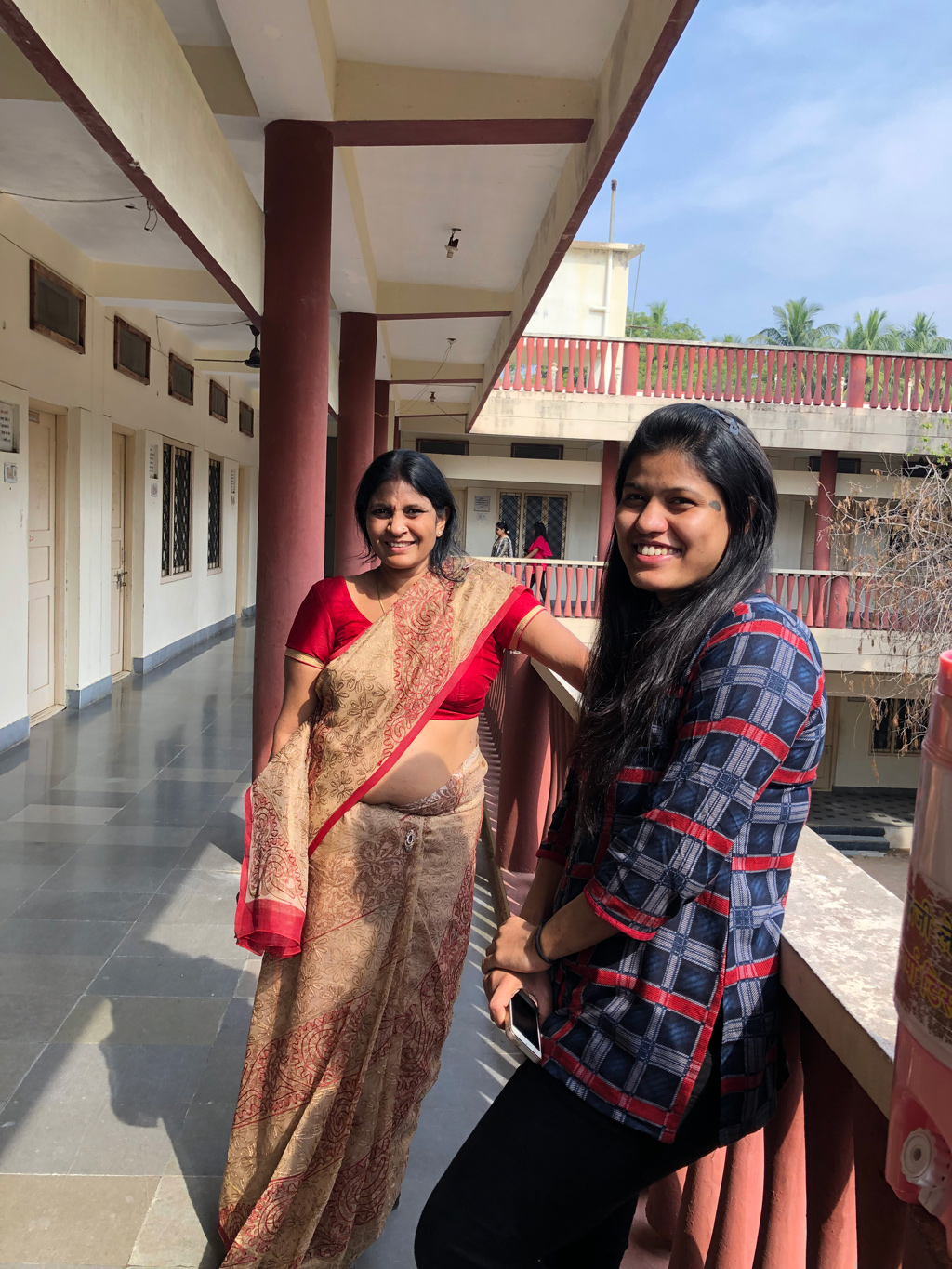
Cost of Accommodation
The accommodation cost is quite nominal. As of December 2018, the prices are as follows.
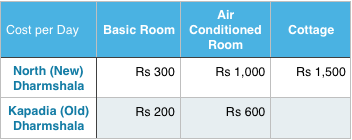
For more current prices and reservations please contact the Kulpakji temple office.
What to Wear at Kulpakji Temple
What to wear when visiting the general temple area
The dress code for visiting the temple without getting up close to statues is very simple
- Dress Modestly.
- No leather articles or accessories.
- Not dressed in full black. Some black is ok.
- Women having periods are asked not to enter the temple.
What to wear to get closer to the idols
If you want to get into the hallways leading to the three main idols, touch an idol or do a Jain Swetamber style pooja you are required to wear pooja clothes.
Jain pooja clothes are pure clothes that essentially means –
- New or clean clothes that are worn just before entering the temple, as opposed to street clothes.
- Clothes are modest and not revealing much skin. For eg saree or suit for women and dhoti and shawl for men.
- The clothes should be comfortable and easy for bending or sitting on the ground for long prayers.
- Jeans, shorts or tights are not recommended for adults.
Jain pooja clothes seem to be all the rage in Gujarat and online. Just google to see how this is a big commercial hit.
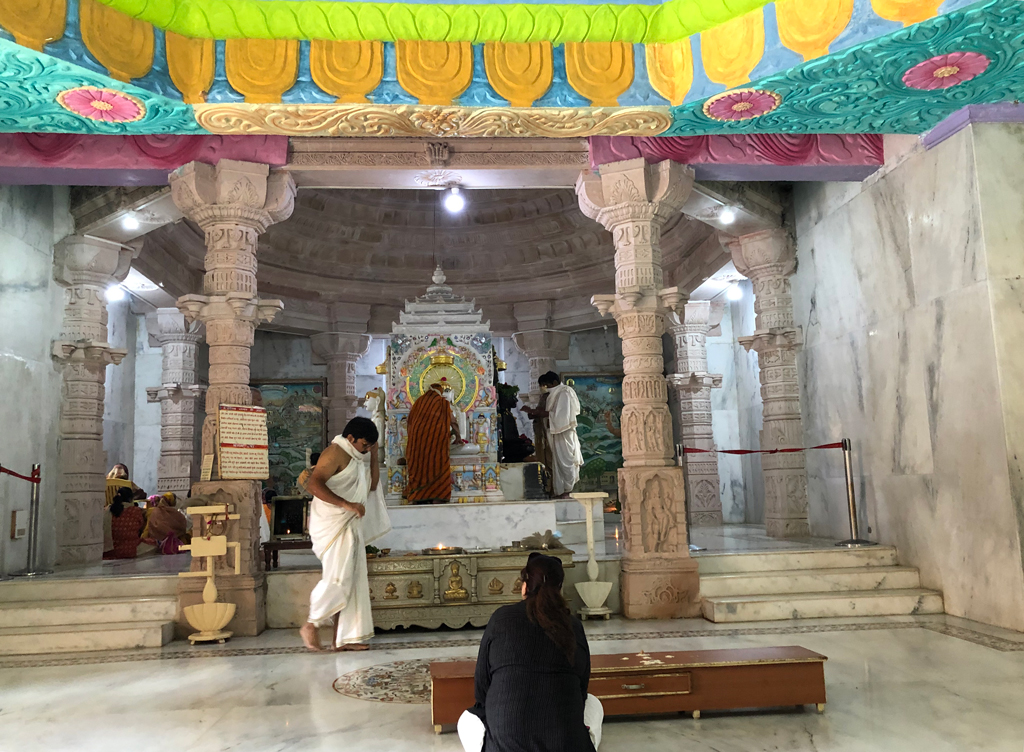
Worshippers generally bring clothes, rent a room and change into Pooja clothes in the Jain dharamshala in Hyderabad or any other place. Tourists coming see Kulpakji as one of the places to visit near Hyderabad, don’t go into the inner rooms for pooja. We can worship or meditate from a distance in normal clothes.
Kulpakji Hours and Important Dates
Kolanupaka Jain temple timings are – 5 am to 8 pm daily.
If you’re visiting from central Hyderabad city, I highly recommend leaving the city before the morning commute rush. The 1.5hr drive could extend to 2.5hrs with the local traffic.
Kulpakji Bhojansala(Dining hall) timings are –
- Breakfast 7.30 am to 9.30 am
- Lunch 11.30 am to 1.30 pm
- Dinner 4.30 pm to sunset
The most important festivals at Kulpakji are –
- Mahavir Jayanthi, the main festival of the temple.
- The annual festival on Chaitra sudh teras (13th) according to the Indian calendar.
- Full moon days (Purnima), particularly the first Purnima after chaturmas (the 4 months of monsoon when Jains limit their travel). This year it was on Nov 23rd, 2018.

Tips to Visit Kulpakji Jain Tirth of South India
- Visit Kulpakji as early as possible in the morning. The benefits of arriving early are many –
- We found the weather to be very pleasant and the temple to be quiet and peaceful. By 10 am worshippers from everywhere started arriving and the temple was packed.
- Traffic in Hyderabad is non-existent which make the drive stress free. We left Hyderguda, Hyderabad at 6:10am and arrived by 7:30am.
- Plan to have a meal at the temple. They serve fresh Jain breakfast, lunch and early dinner every day.
- Take some cash for donation, so you pay it forward for the next visitor.
- Don’t use the general restrooms. They stink.
- Rent a room in the Jain dharamshala even if you’re on a short visit. The rooms have a clean bathroom (I’m told) and bed to lie down for rest. Since we didn’t know, we asked another lady if we could use her restroom and she was totally welcoming.
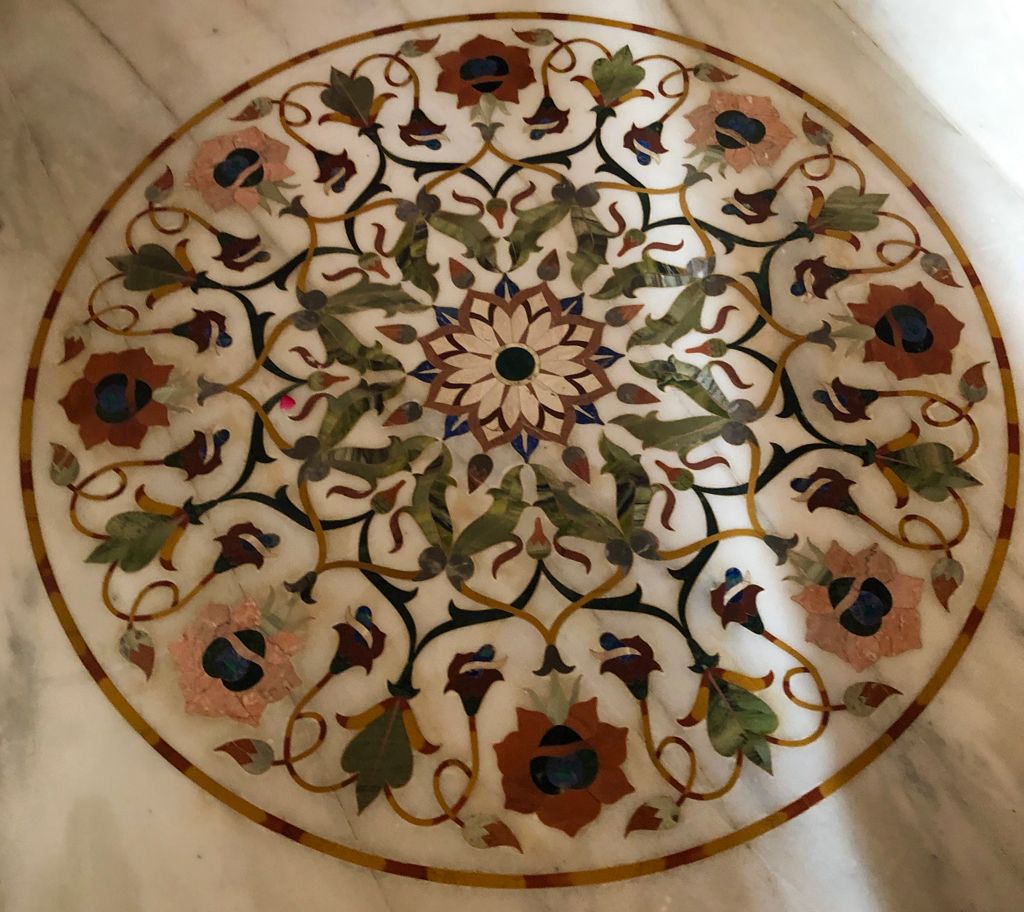
People at Kulpakji Temple
We met some amazing people in Kulpakji Jain temple – the 90-year-old visitor from Madras; the third generation caretaker; the worshipper for 50 years; the staff and the awesome Kulpakji temple manager. Read all about the people of Kolunapaka Jain swetambar temple at People of Kulpakji. Everyone had fascinating stories of the temple and its history.
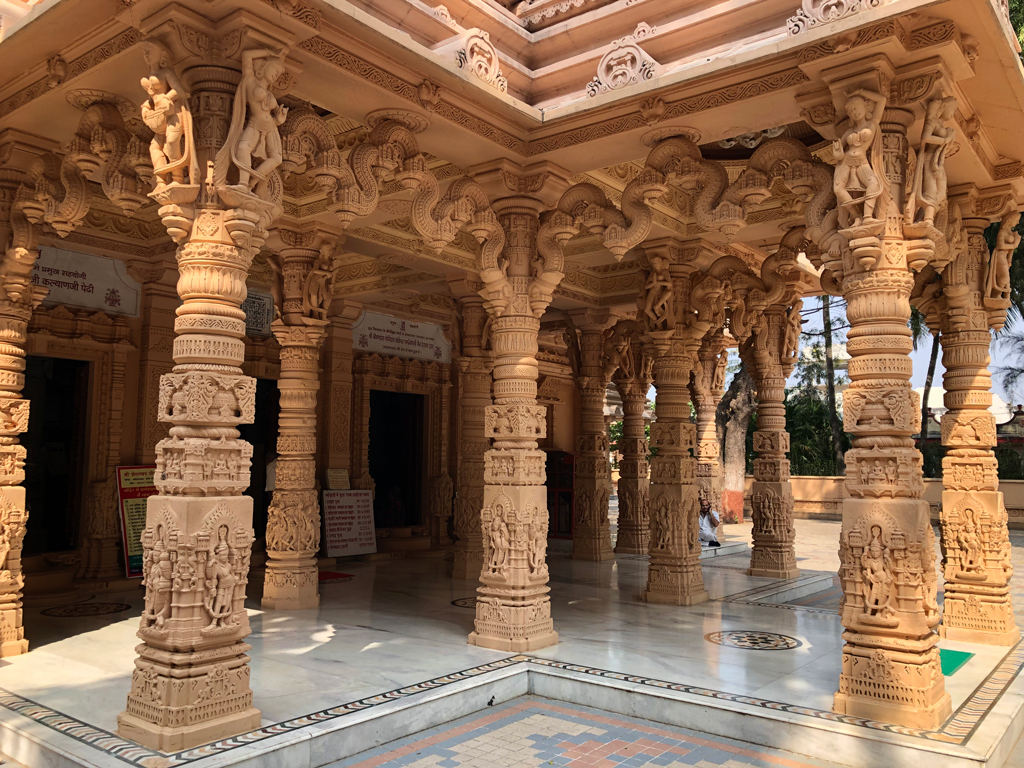
Restoration of Kulpakji Temple
In 1996, the community rebuilt the temple in its current state. 160 artisans were brought in from Rajasthan, Gujarat, and Agra to create the beautiful new temple around the original structure. The restored temple has red standstone carvings like the temples of Jaisalmer and colorful marble inlays as seen in Taj Mahal.

Before the restoration, Kulpakji temple lay in ruins and almost unreachable for visitors. Now, its a well kept living temple thriving with visitors that have easy access, clean dharamshala rooms to stay, good food to eat and clean temple to worship. Kulpakji temple has been restored in good taste and artistic style but I can’t tell if it has any resemblance with the original temple. So, it’s now one of the places to visit near hyderabad. The nice Jain dharamshala and dining make the visit that much more pleasant.
In any case, Kulpakji no longer has the vibe of an ancient historic or archeological site. The historic artifacts are well hidden in the small dusty museum.
What are your thoughts on the transformation of old to new?
Is it better to modernize an ancient temple or leave it as-is?
Is it right for Kulpakji temple to become one of the touristy places to visit near Hyderabad?
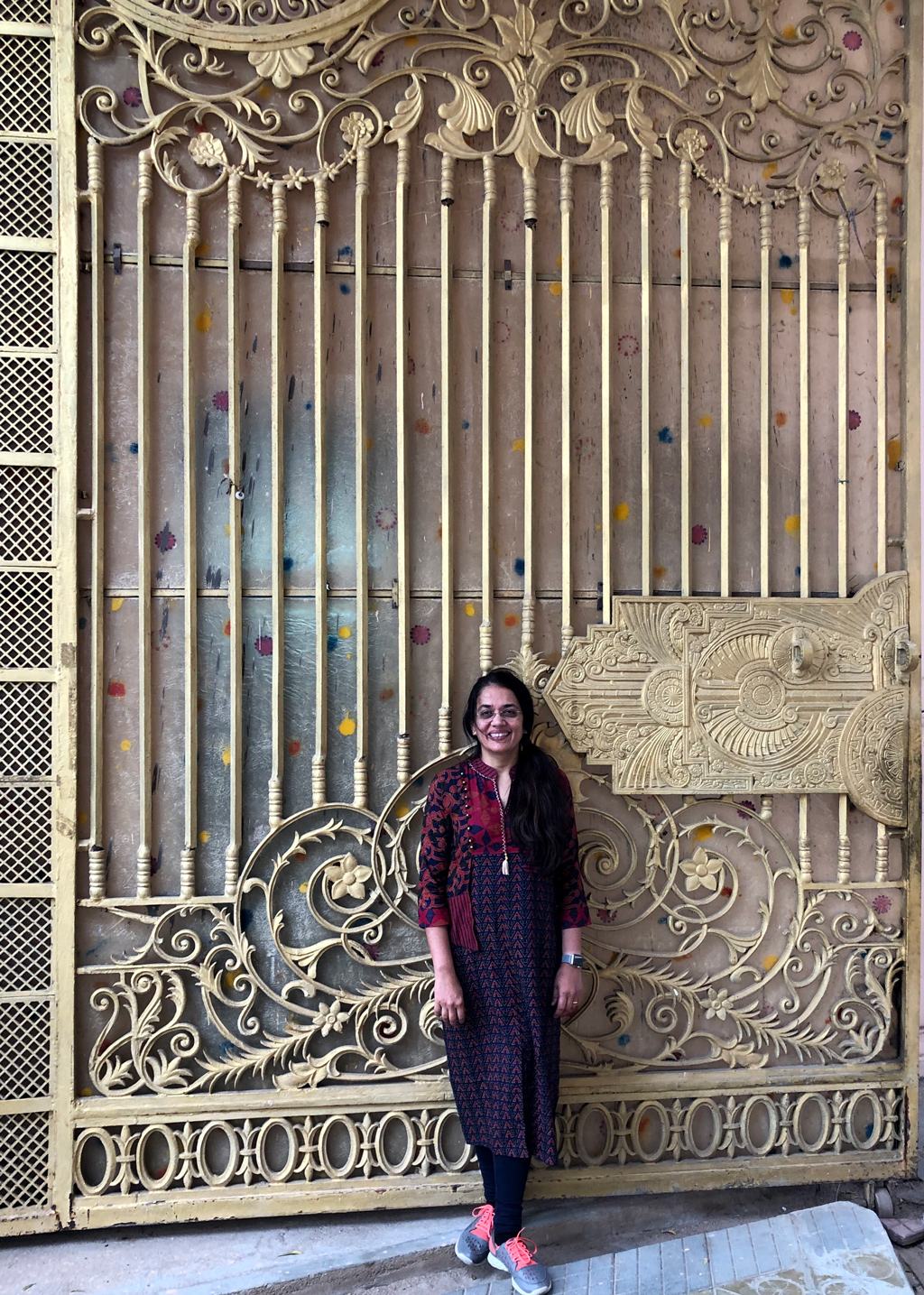
Related Articles
First written mention of ‘Jain’ is in Feroz Shah Kotla
The lifestyle of the Jains traders in Jaisalmer

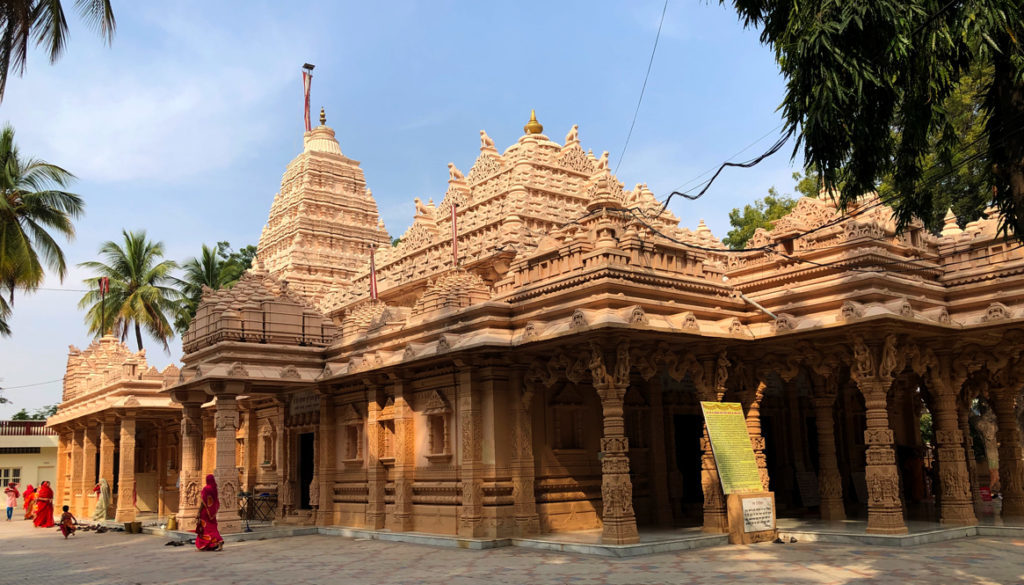


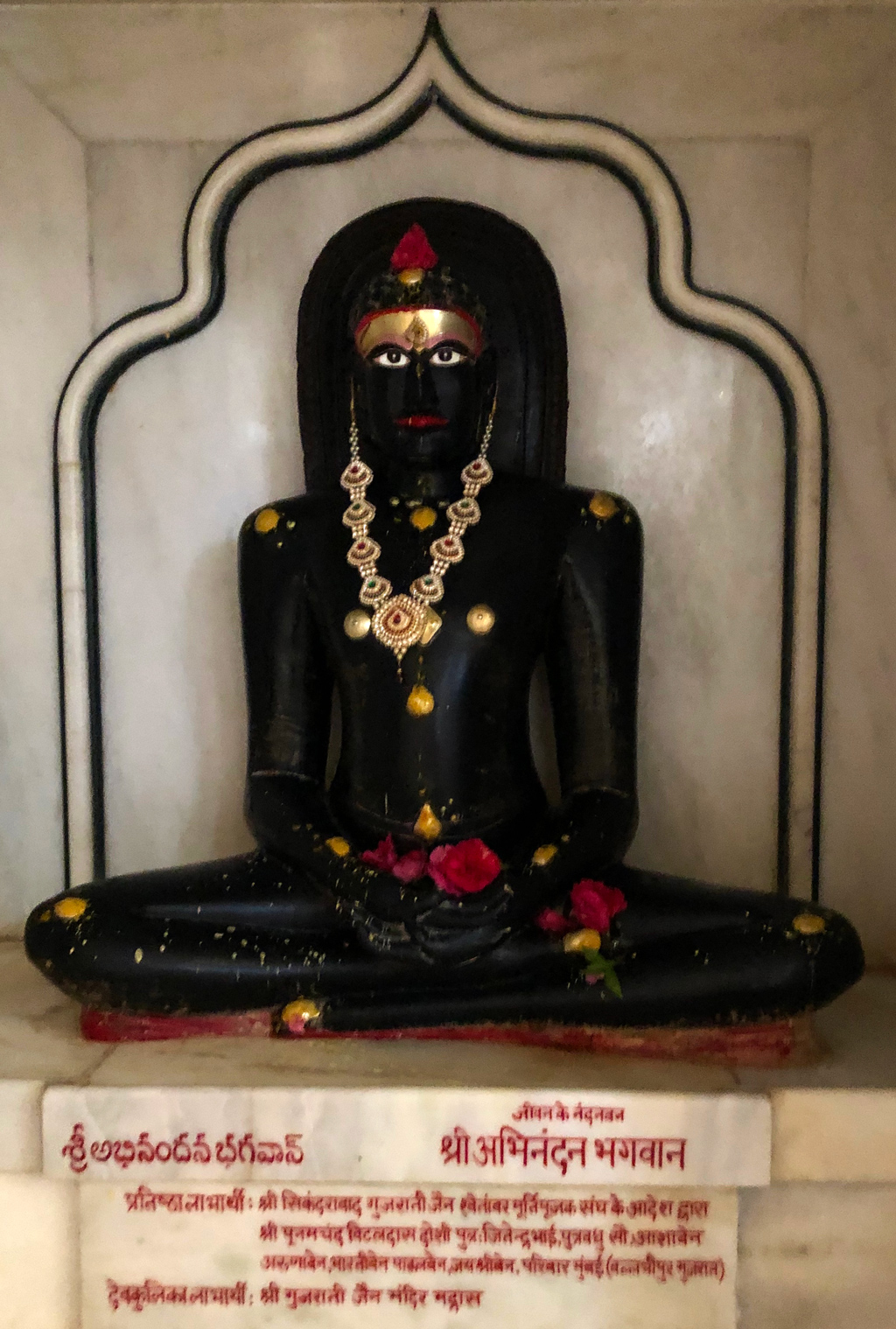
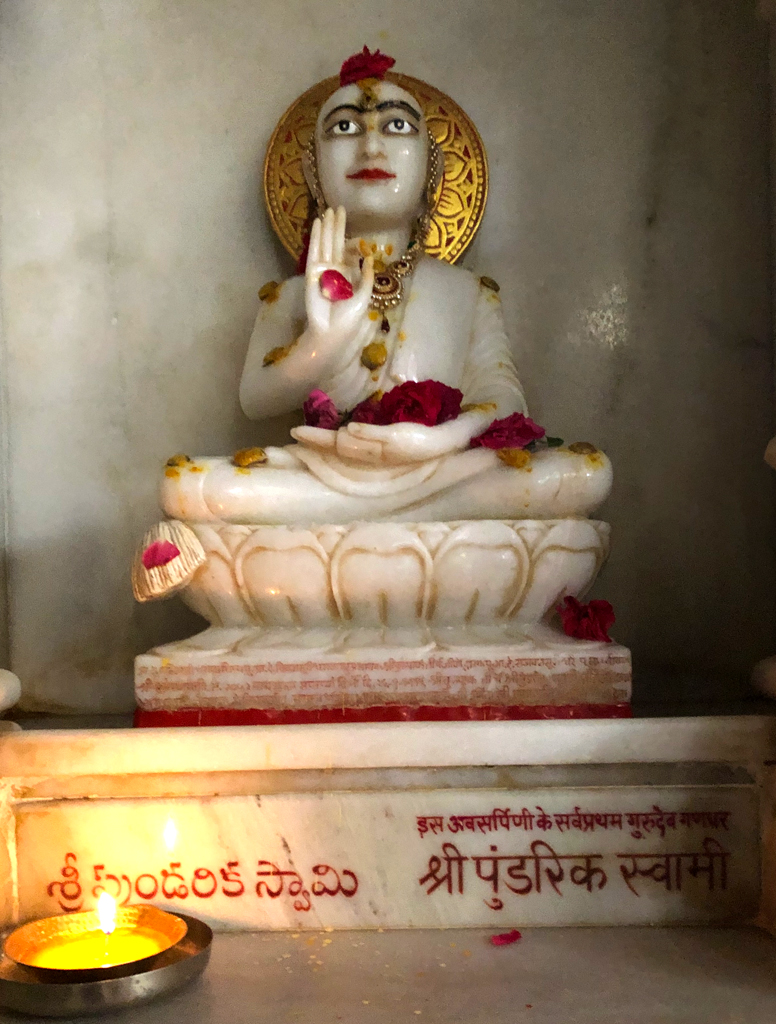
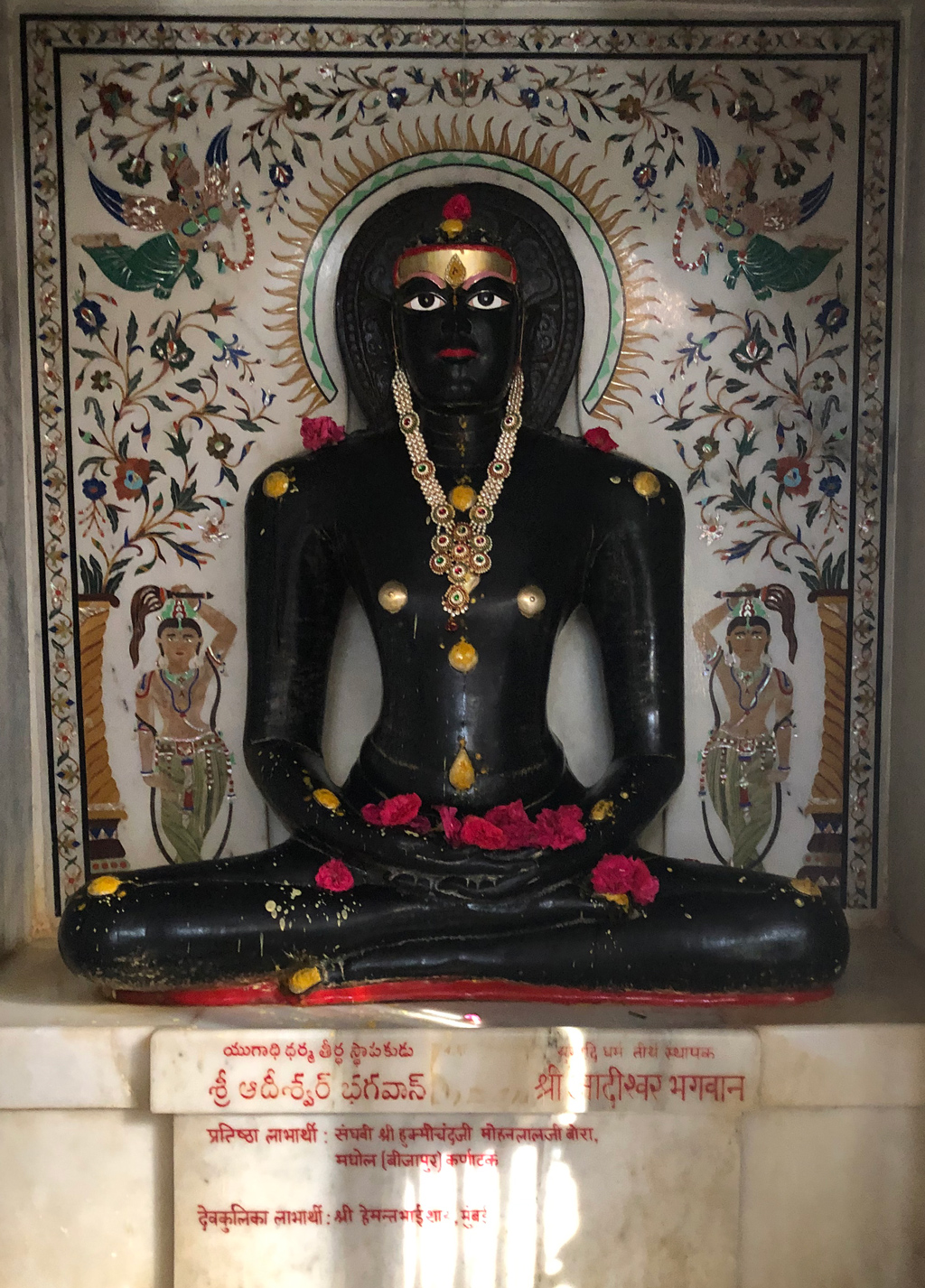
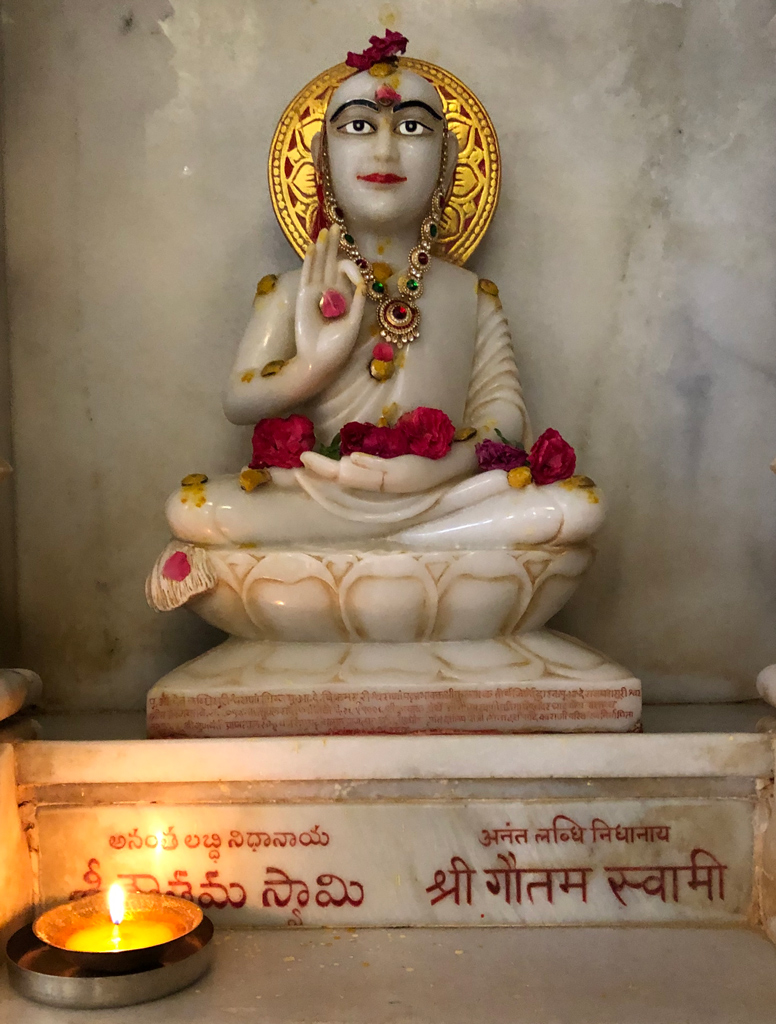

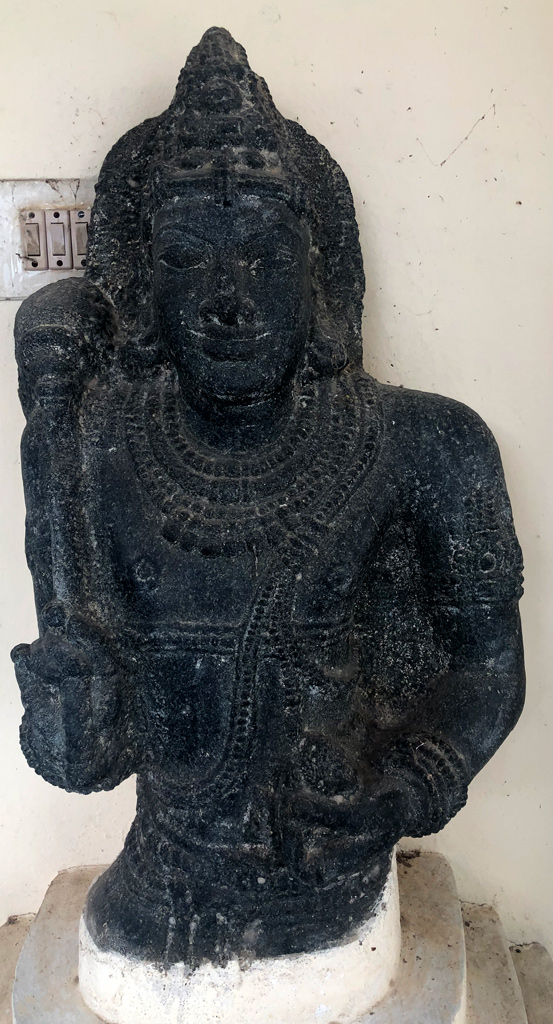
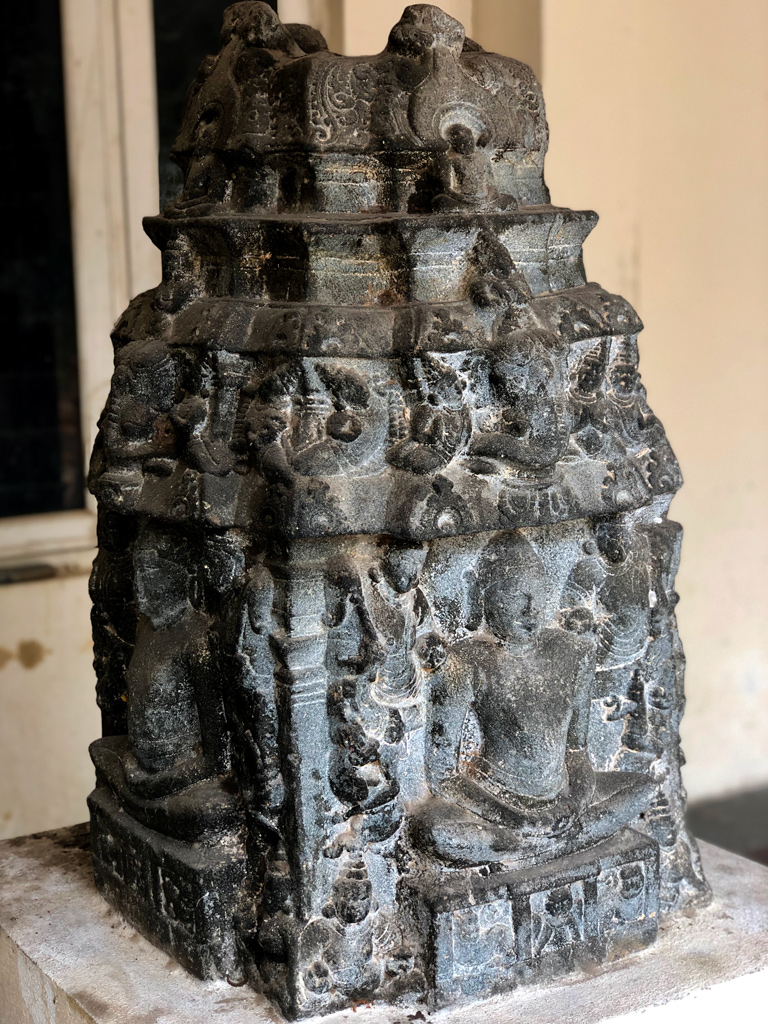
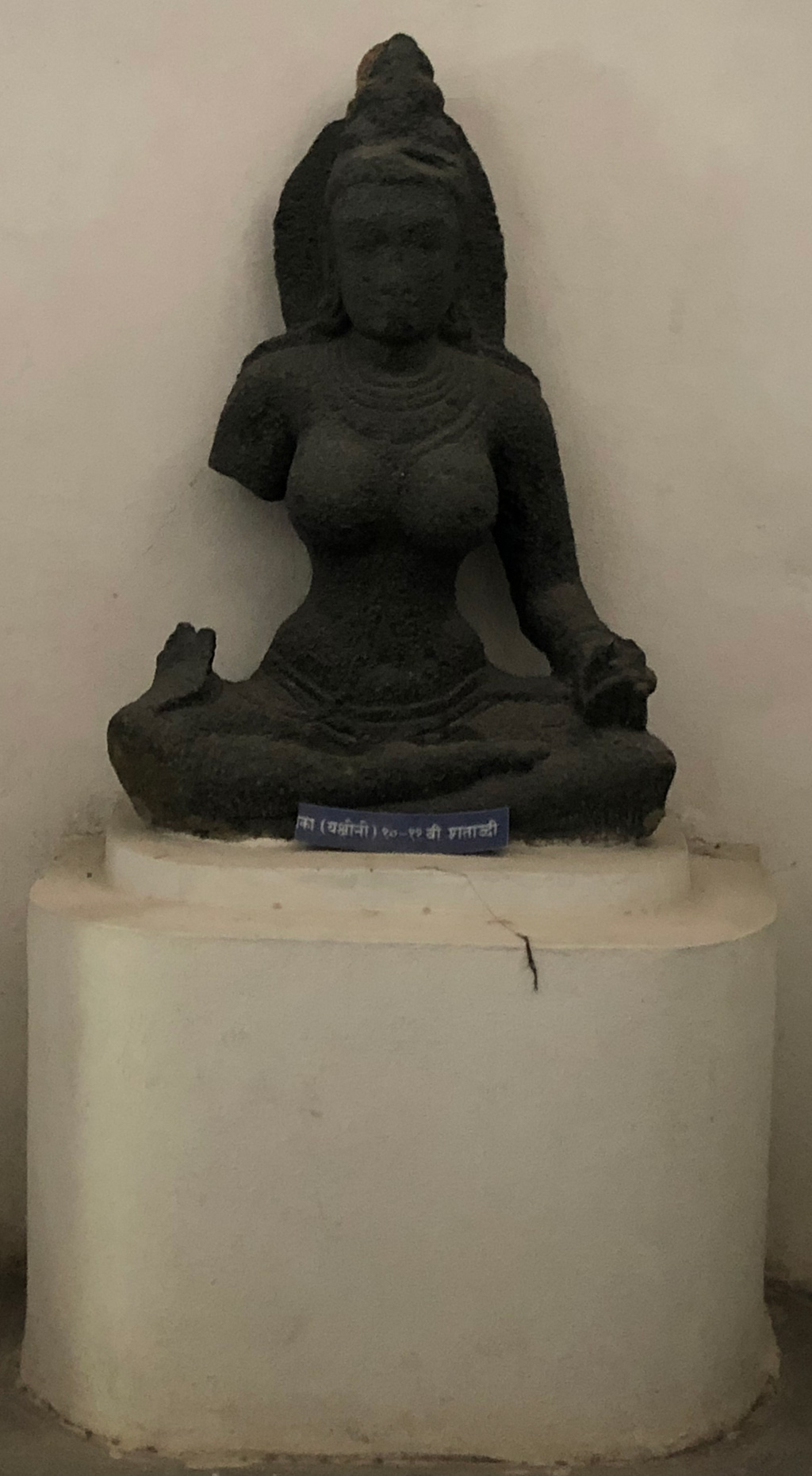
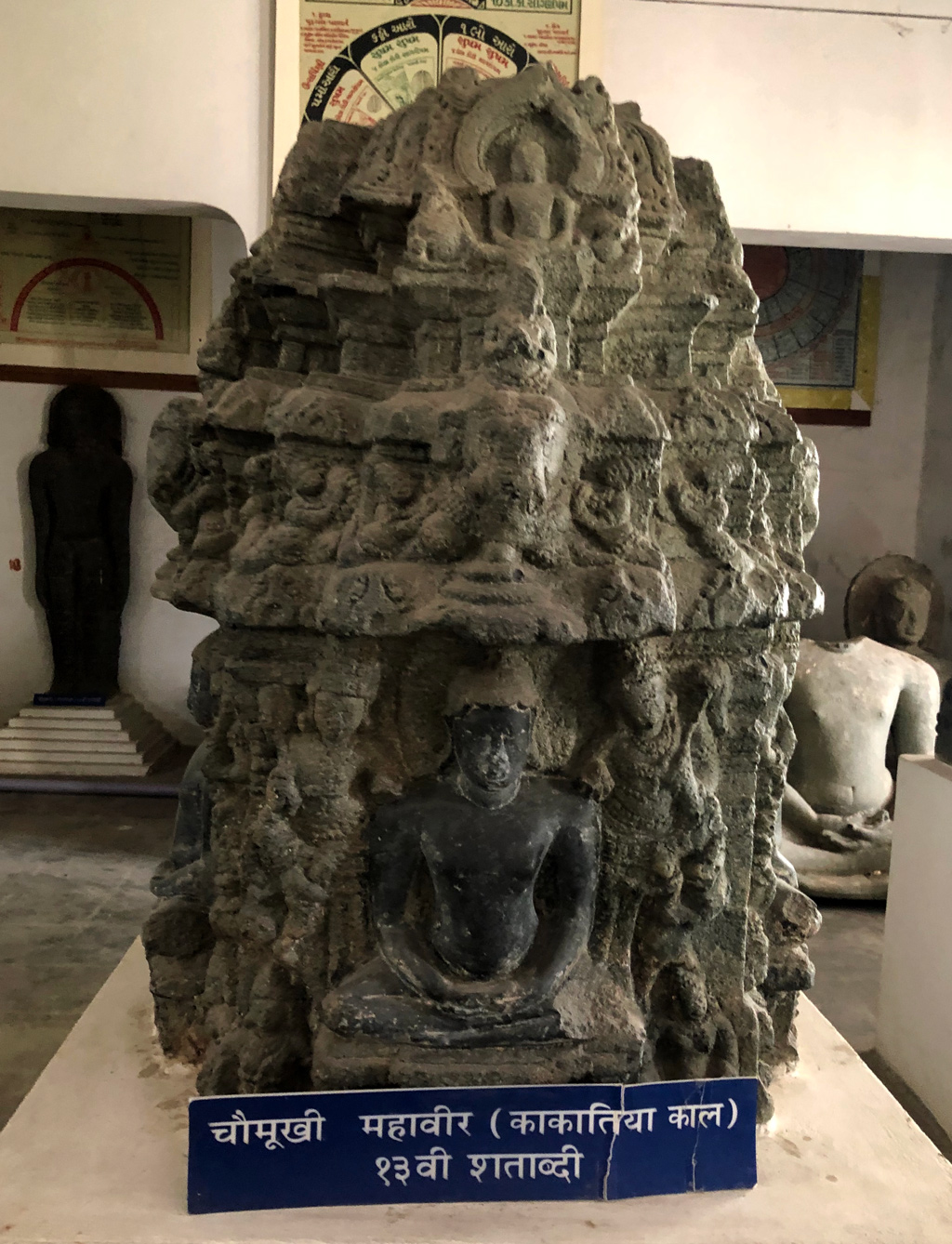
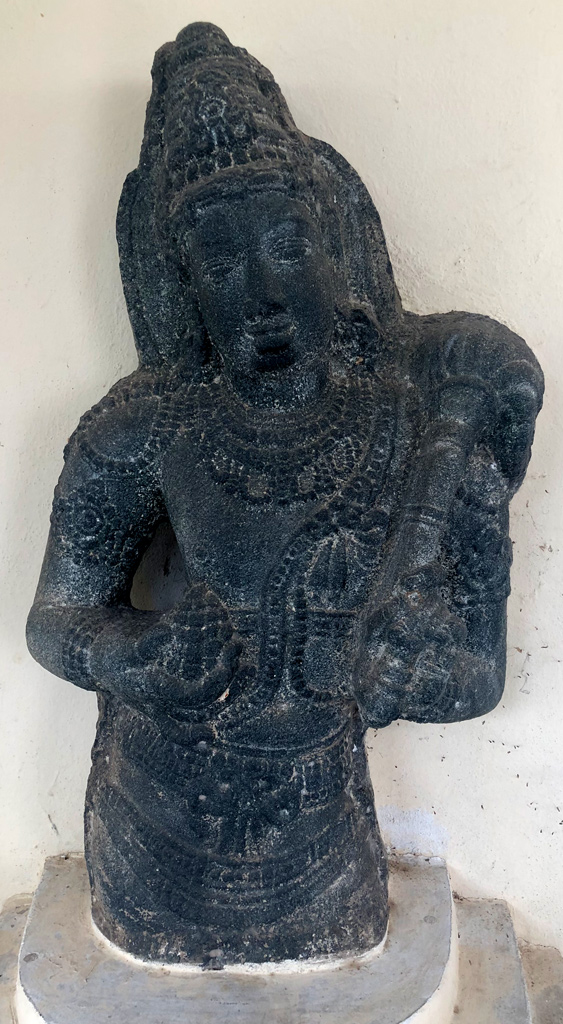
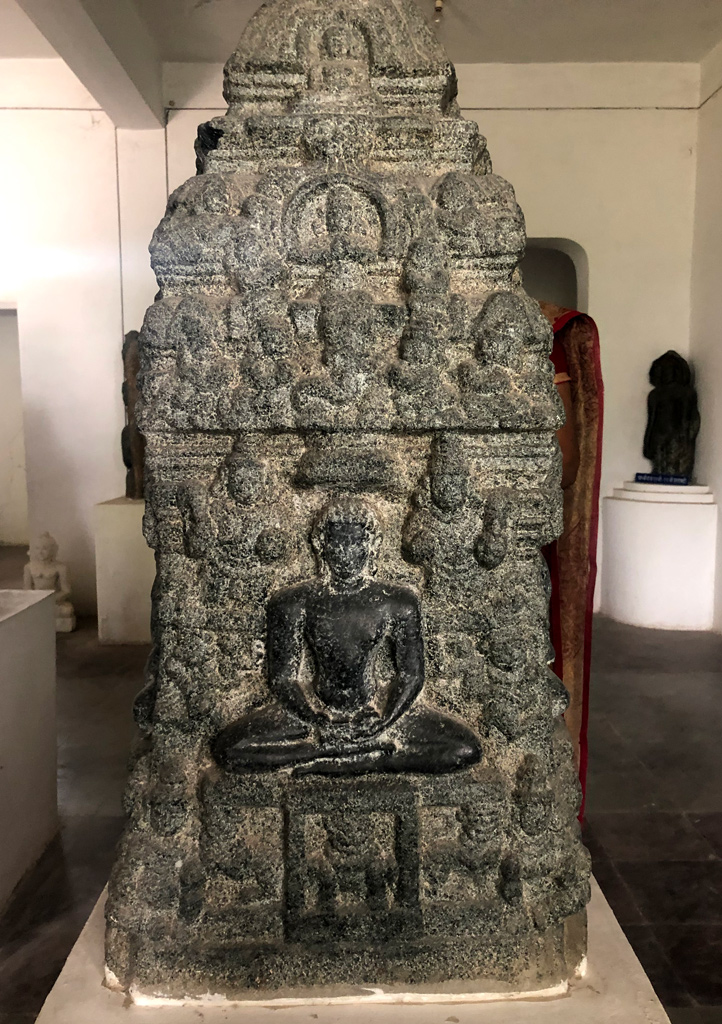
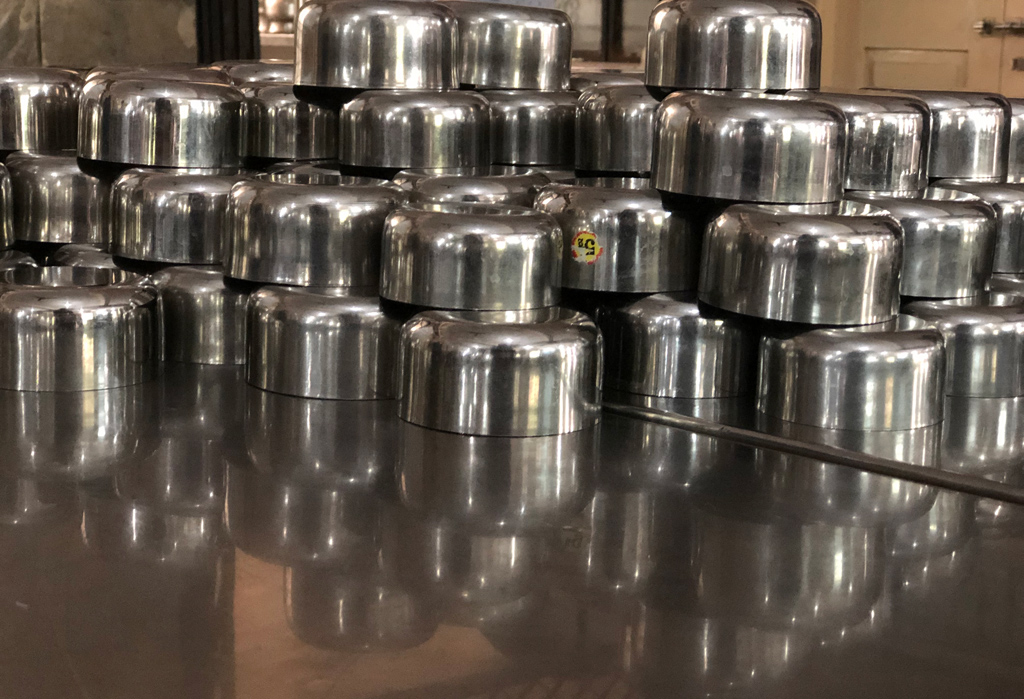
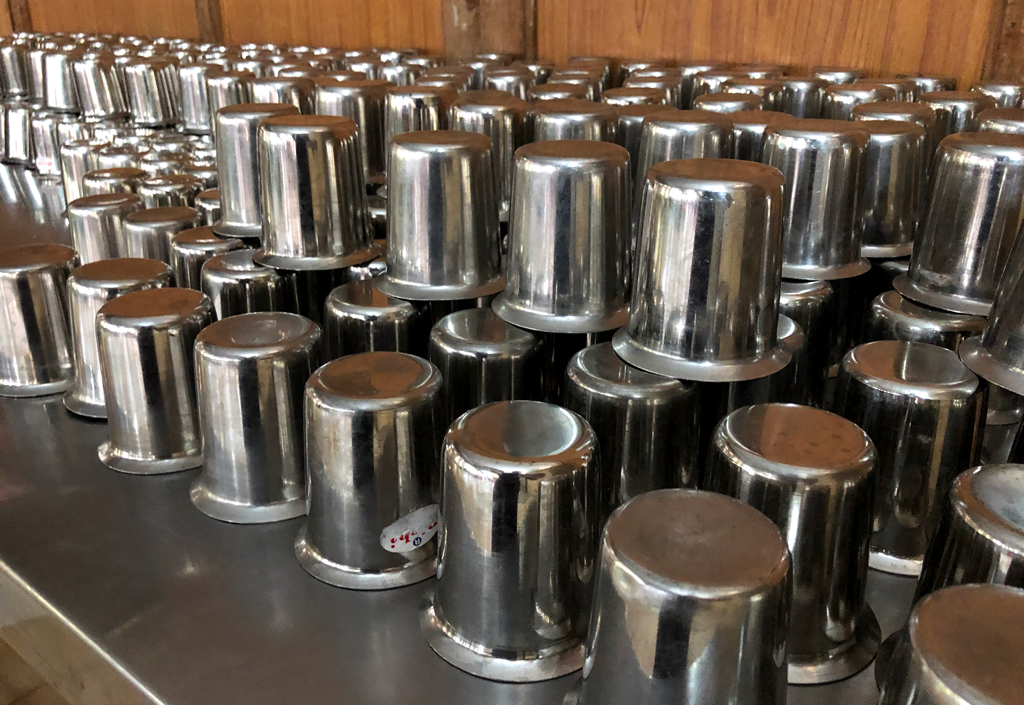
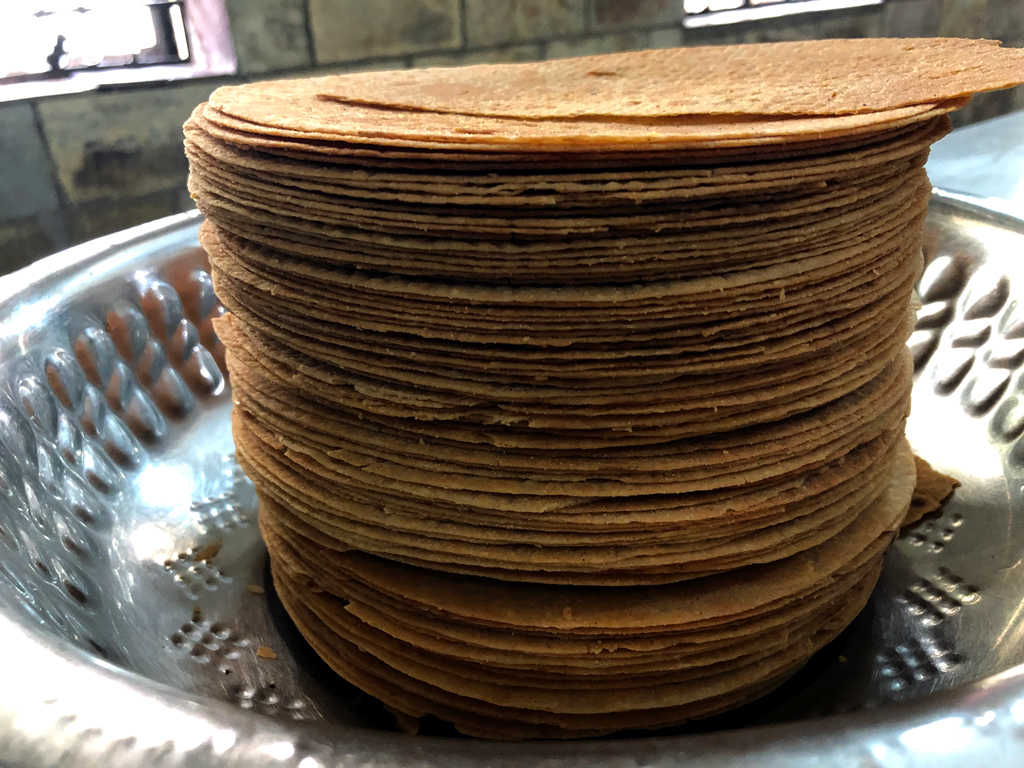
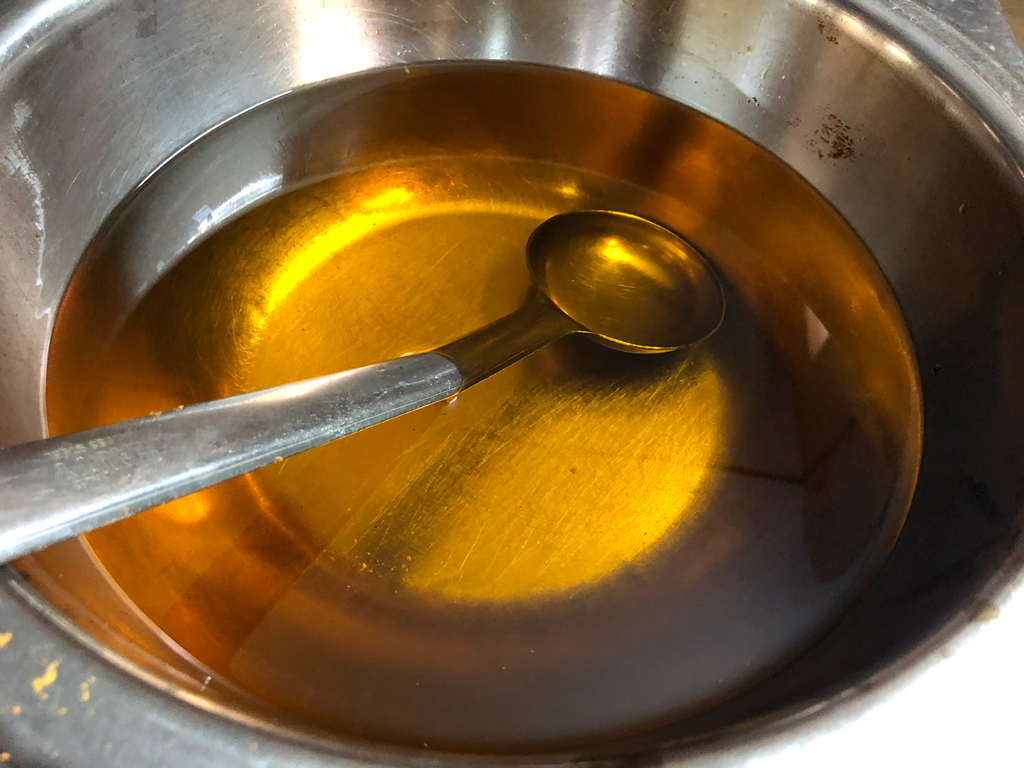
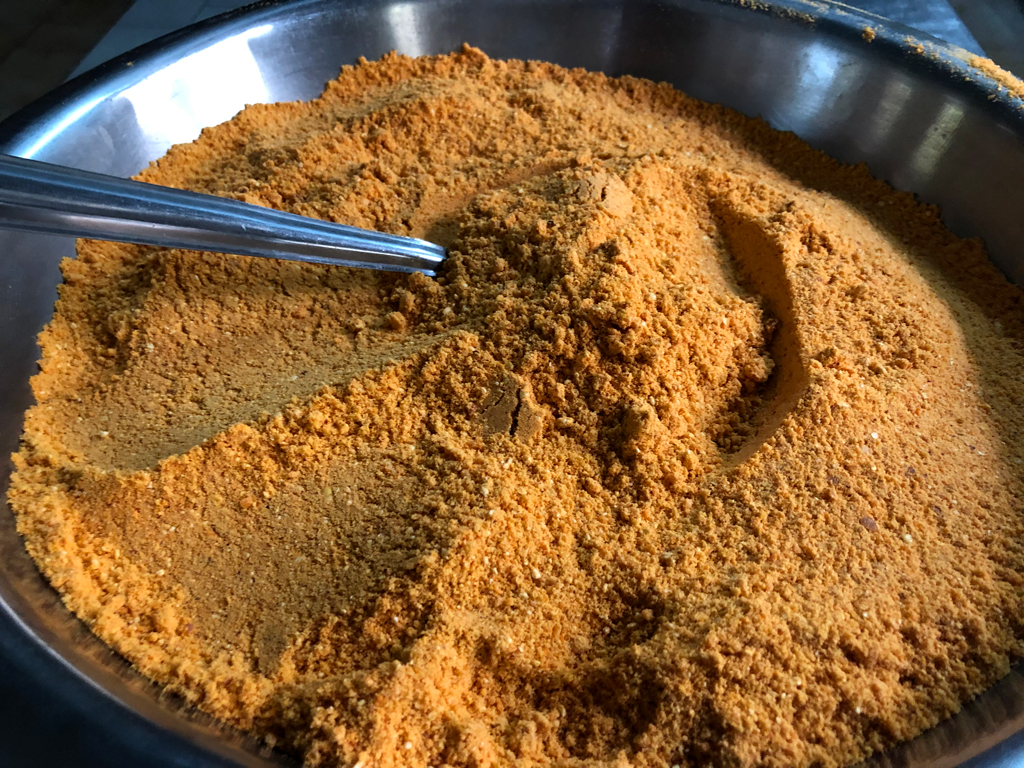
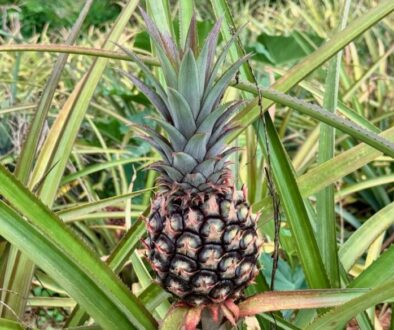
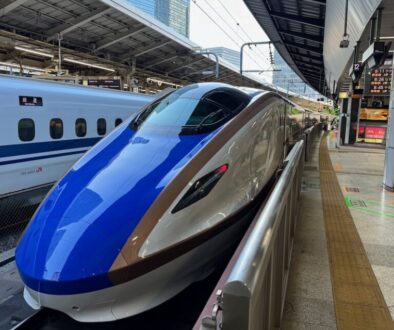
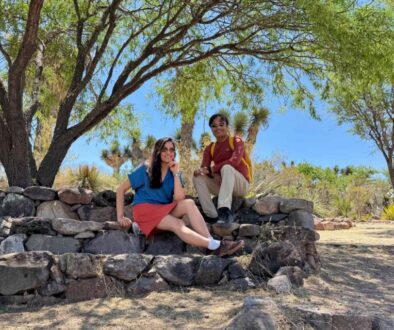

arv
December 6, 2018 @ 4:27 am
While I have heard of Jain temples and Jainism in Karnataka, this is something new for me. Recently, I came to know that there are many ancient Jain temples in Orissa too. This is a hidden gem. You are right, Hyderabad for a tourist starts with Golkonda Fort/ Salarjung Museum and ends with Ramoji film city. I’m sure if they can add some more places it might become attractive for the tourists.
Thanks for posting this here and highlighting this little gem.
Jyoti
December 6, 2018 @ 6:30 am
Thanks, Arv! That’s precisely the challenge. When I was looking for places to visit around Hyderabad, the choices were so few. There’s only so many times that one can visit Golkonda Fort, Salarjung Museum and Ramoji film city. I’m hoping there are more hidden cultural gems to be discovered on our next visit.
Kamal Kothari
December 6, 2018 @ 8:56 pm
Wonderful narration of the temple it’s history and extensive pictorial depiction. Very interesting depction
Jyoti
December 7, 2018 @ 4:03 am
Thank you so much!